
Exploring 250+ Machine Learning Research Topics
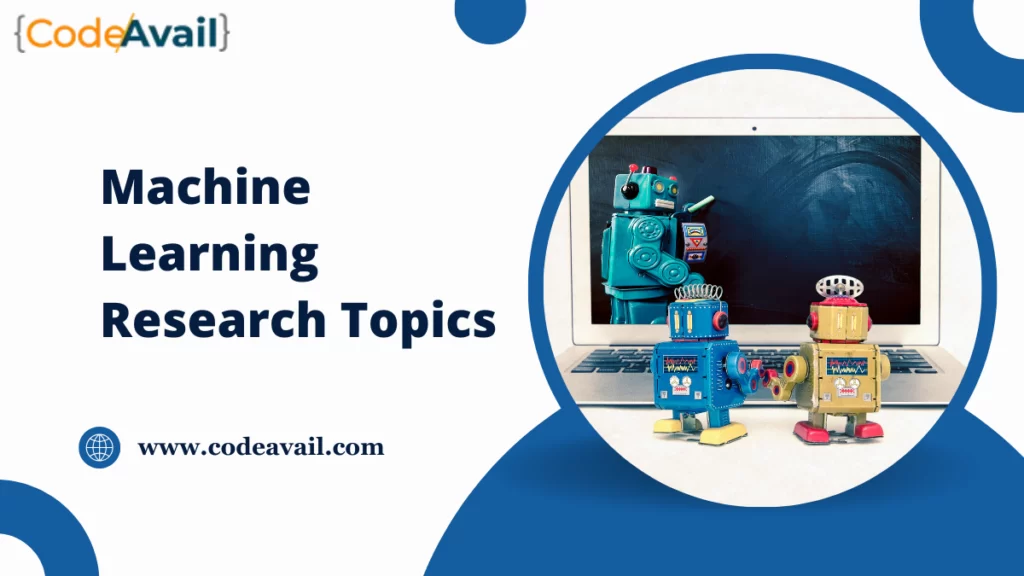
In recent years, machine learning has become super popular and grown very quickly. This happened because technology got better, and there’s a lot more data available. Because of this, we’ve seen lots of new and amazing things happen in different areas. Machine learning research is what makes all these cool things possible. In this blog, we’ll talk about machine learning research topics, why they’re important, how you can pick one, what areas are popular to study, what’s new and exciting, the tough problems, and where you can find help if you want to be a researcher.
Why Does Machine Learning Research Matter?
Table of Contents
Machine learning research is at the heart of the AI revolution. It underpins the development of intelligent systems capable of making predictions, automating tasks, and improving decision-making across industries. The importance of this research can be summarized as follows:
Advancements in Technology
The growth of machine learning research has led to the development of powerful algorithms, tools, and frameworks. Numerous industries, including healthcare, banking, autonomous cars, and natural language processing, have found use for these technology.
As researchers continue to push the boundaries of what’s possible, we can expect even more transformative technologies to emerge.
Real-world Applications
Machine learning research has brought about tangible changes in our daily lives. Voice assistants like Siri and Alexa, recommendation systems on streaming platforms, and personalized healthcare diagnostics are just a few examples of how this research impacts our world.
By working on new research topics, scientists can further refine these applications and create new ones.
Economic and Industrial Impacts
The economic implications of machine learning research are substantial. Companies that harness the power of machine learning gain a competitive edge in the market.
This creates a demand for skilled machine learning researchers, driving job opportunities and contributing to economic growth.
How to Choose the Machine Learning Research Topics?
Selecting the right machine learning research topics is crucial for your success as a machine learning researcher. Here’s a guide to help you make an informed decision:
- Understanding Your Interests
Start by considering your personal interests. Machine learning is a broad field with applications in virtually every sector. By choosing a topic that aligns with your passions, you’ll stay motivated and engaged throughout your research journey.
- Reviewing Current Trends
Stay updated on the latest trends in machine learning. Attend conferences, read research papers, and engage with the community to identify emerging research topics. Current trends often lead to exciting breakthroughs.
- Identifying Gaps in Existing Research
Sometimes, the most promising research topics involve addressing gaps in existing knowledge. These gaps may become evident through your own experiences, discussions with peers, or in the course of your studies.
- Collaborating with Experts
Collaboration is key in research. Working with experts in the field can help you refine your research topic and gain valuable insights. Seek mentors and collaborators who can guide you.
250+ Machine Learning Research Topics: Category-wise
Supervised learning.
- Explainable AI for Decision Support
- Few-shot Learning Methods
- Time Series Forecasting with Deep Learning
- Handling Imbalanced Datasets in Classification
- Regression Techniques for Non-linear Data
- Transfer Learning in Supervised Settings
- Multi-label Classification Strategies
- Semi-Supervised Learning Approaches
- Novel Feature Selection Methods
- Anomaly Detection in Supervised Scenarios
- Federated Learning for Distributed Supervised Models
- Ensemble Learning for Improved Accuracy
- Automated Hyperparameter Tuning
- Ethical Implications in Supervised Models
- Interpretability of Deep Neural Networks.
Unsupervised Learning
- Unsupervised Clustering of High-dimensional Data
- Semi-Supervised Clustering Approaches
- Density Estimation in Unsupervised Learning
- Anomaly Detection in Unsupervised Settings
- Transfer Learning for Unsupervised Tasks
- Representation Learning in Unsupervised Learning
- Outlier Detection Techniques
- Generative Models for Data Synthesis
- Manifold Learning in High-dimensional Spaces
- Unsupervised Feature Selection
- Privacy-Preserving Unsupervised Learning
- Community Detection in Complex Networks
- Clustering Interpretability and Visualization
- Unsupervised Learning for Image Segmentation
- Autoencoders for Dimensionality Reduction.
Reinforcement Learning
- Deep Reinforcement Learning in Real-world Applications
- Safe Reinforcement Learning for Autonomous Systems
- Transfer Learning in Reinforcement Learning
- Imitation Learning and Apprenticeship Learning
- Multi-agent Reinforcement Learning
- Explainable Reinforcement Learning Policies
- Hierarchical Reinforcement Learning
- Model-based Reinforcement Learning
- Curriculum Learning in Reinforcement Learning
- Reinforcement Learning in Robotics
- Exploration vs. Exploitation Strategies
- Reward Function Design and Ethical Considerations
- Reinforcement Learning in Healthcare
- Continuous Action Spaces in RL
- Reinforcement Learning for Resource Management.
Natural Language Processing (NLP)
- Multilingual and Cross-lingual NLP
- Contextualized Word Embeddings
- Bias Detection and Mitigation in NLP
- Named Entity Recognition for Low-resource Languages
- Sentiment Analysis in Social Media Text
- Dialogue Systems for Improved Customer Service
- Text Summarization for News Articles
- Low-resource Machine Translation
- Explainable NLP Models
- Coreference Resolution in NLP
- Question Answering in Specific Domains
- Detecting Fake News and Misinformation
- NLP for Healthcare: Clinical Document Understanding
- Emotion Analysis in Text
- Text Generation with Controlled Attributes.
Computer Vision
- Video Action Recognition and Event Detection
- Object Detection in Challenging Conditions (e.g., low light)
- Explainable Computer Vision Models
- Image Captioning for Accessibility
- Large-scale Image Retrieval
- Domain Adaptation in Computer Vision
- Fine-grained Image Classification
- Facial Expression Recognition
- Visual Question Answering
- Self-supervised Learning for Visual Representations
- Weakly Supervised Object Localization
- Human Pose Estimation in 3D
- Scene Understanding in Autonomous Vehicles
- Image Super-resolution
- Gaze Estimation for Human-Computer Interaction.
Deep Learning
- Neural Architecture Search for Efficient Models
- Self-attention Mechanisms and Transformers
- Interpretability in Deep Learning Models
- Robustness of Deep Neural Networks
- Generative Adversarial Networks (GANs) for Data Augmentation
- Neural Style Transfer in Art and Design
- Adversarial Attacks and Defenses
- Neural Networks for Audio and Speech Processing
- Explainable AI for Healthcare Diagnosis
- Automated Machine Learning (AutoML)
- Reinforcement Learning with Deep Neural Networks
- Model Compression and Quantization
- Lifelong Learning with Deep Learning Models
- Multimodal Learning with Vision and Language
- Federated Learning for Privacy-preserving Deep Learning.
Explainable AI
- Visualizing Model Decision Boundaries
- Saliency Maps and Feature Attribution
- Rule-based Explanations for Black-box Models
- Contrastive Explanations for Model Interpretability
- Counterfactual Explanations and What-if Analysis
- Human-centered AI for Explainable Healthcare
- Ethics and Fairness in Explainable AI
- Explanation Generation for Natural Language Processing
- Explainable AI in Financial Risk Assessment
- User-friendly Interfaces for Model Interpretability
- Scalability and Efficiency in Explainable Models
- Hybrid Models for Combined Accuracy and Explainability
- Post-hoc vs. Intrinsic Explanations
- Evaluation Metrics for Explanation Quality
- Explainable AI for Autonomous Vehicles.
Transfer Learning
- Zero-shot Learning and Few-shot Learning
- Cross-domain Transfer Learning
- Domain Adaptation for Improved Generalization
- Multilingual Transfer Learning in NLP
- Pretraining and Fine-tuning Techniques
- Lifelong Learning and Continual Learning
- Domain-specific Transfer Learning Applications
- Model Distillation for Knowledge Transfer
- Contrastive Learning for Transfer Learning
- Self-training and Pseudo-labeling
- Dynamic Adaption of Pretrained Models
- Privacy-Preserving Transfer Learning
- Unsupervised Domain Adaptation
- Negative Transfer Avoidance in Transfer Learning.
Federated Learning
- Secure Aggregation in Federated Learning
- Communication-efficient Federated Learning
- Privacy-preserving Techniques in Federated Learning
- Federated Transfer Learning
- Heterogeneous Federated Learning
- Real-world Applications of Federated Learning
- Federated Learning for Edge Devices
- Federated Learning for Healthcare Data
- Differential Privacy in Federated Learning
- Byzantine-robust Federated Learning
- Federated Learning with Non-IID Data
- Model Selection in Federated Learning
- Scalable Federated Learning for Large Datasets
- Client Selection and Sampling Strategies
- Global Model Update Synchronization in Federated Learning.
Quantum Machine Learning
- Quantum Neural Networks and Quantum Circuit Learning
- Quantum-enhanced Optimization for Machine Learning
- Quantum Data Compression and Quantum Principal Component Analysis
- Quantum Kernels and Quantum Feature Maps
- Quantum Variational Autoencoders
- Quantum Transfer Learning
- Quantum-inspired Classical Algorithms for ML
- Hybrid Quantum-Classical Models
- Quantum Machine Learning on Near-term Quantum Devices
- Quantum-inspired Reinforcement Learning
- Quantum Computing for Quantum Chemistry and Drug Discovery
- Quantum Machine Learning for Finance
- Quantum Data Structures and Quantum Databases
- Quantum-enhanced Cryptography in Machine Learning
- Quantum Generative Models and Quantum GANs.
Ethical AI and Bias Mitigation
- Fairness-aware Machine Learning Algorithms
- Bias Detection and Mitigation in Real-world Data
- Explainable AI for Ethical Decision Support
- Algorithmic Accountability and Transparency
- Privacy-preserving AI and Data Governance
- Ethical Considerations in AI for Healthcare
- Fairness in Recommender Systems
- Bias and Fairness in NLP Models
- Auditing AI Systems for Bias
- Societal Implications of AI in Criminal Justice
- Ethical AI Education and Training
- Bias Mitigation in Autonomous Vehicles
- Fair AI in Financial and Hiring Decisions
- Case Studies in Ethical AI Failures
- Legal and Policy Frameworks for Ethical AI.
Meta-Learning and AutoML
- Neural Architecture Search (NAS) for Efficient Models
- Transfer Learning in NAS
- Reinforcement Learning for NAS
- Multi-objective NAS
- Automated Data Augmentation
- Neural Architecture Optimization for Edge Devices
- Bayesian Optimization for AutoML
- Model Compression and Quantization in AutoML
- AutoML for Federated Learning
- AutoML in Healthcare Diagnostics
- Explainable AutoML
- Cost-sensitive Learning in AutoML
- AutoML for Small Data
- Human-in-the-Loop AutoML.
AI for Healthcare and Medicine
- Disease Prediction and Early Diagnosis
- Medical Image Analysis with Deep Learning
- Drug Discovery and Molecular Modeling
- Electronic Health Record Analysis
- Predictive Analytics in Healthcare
- Personalized Treatment Planning
- Healthcare Fraud Detection
- Telemedicine and Remote Patient Monitoring
- AI in Radiology and Pathology
- AI in Drug Repurposing
- AI for Medical Robotics and Surgery
- Genomic Data Analysis
- AI-powered Mental Health Assessment
- Explainable AI in Healthcare Decision Support
- AI in Epidemiology and Outbreak Prediction.
AI in Finance and Investment
- Algorithmic Trading and High-frequency Trading
- Credit Scoring and Risk Assessment
- Fraud Detection and Anti-money Laundering
- Portfolio Optimization with AI
- Financial Market Prediction
- Sentiment Analysis in Financial News
- Explainable AI in Financial Decision-making
- Algorithmic Pricing and Dynamic Pricing Strategies
- AI in Cryptocurrency and Blockchain
- Customer Behavior Analysis in Banking
- Explainable AI in Credit Decisioning
- AI in Regulatory Compliance
- Ethical AI in Financial Services
- AI for Real Estate Investment
- Automated Financial Reporting.
AI in Climate Change and Sustainability
- Climate Modeling and Prediction
- Renewable Energy Forecasting
- Smart Grid Optimization
- Energy Consumption Forecasting
- Carbon Emission Reduction with AI
- Ecosystem Monitoring and Preservation
- Precision Agriculture with AI
- AI for Wildlife Conservation
- Natural Disaster Prediction and Management
- Water Resource Management with AI
- Sustainable Transportation and Urban Planning
- Climate Change Mitigation Strategies with AI
- Environmental Impact Assessment with Machine Learning
- Eco-friendly Supply Chain Optimization
- Ethical AI in Climate-related Decision Support.
Data Privacy and Security
- Differential Privacy Mechanisms
- Federated Learning for Privacy-preserving AI
- Secure Multi-Party Computation
- Privacy-enhancing Technologies in Machine Learning
- Homomorphic Encryption for Machine Learning
- Ethical Considerations in Data Privacy
- Privacy-preserving AI in Healthcare
- AI for Secure Authentication and Access Control
- Blockchain and AI for Data Security
- Explainable Privacy in Machine Learning
- Privacy-preserving AI in Government and Public Services
- Privacy-compliant AI for IoT and Edge Devices
- Secure AI Models Sharing and Deployment
- Privacy-preserving AI in Financial Transactions
- AI in the Legal Frameworks of Data Privacy.
Global Collaboration in Research
- International Research Partnerships and Collaboration Models
- Multilingual and Cross-cultural AI Research
- Addressing Global Healthcare Challenges with AI
- Ethical Considerations in International AI Collaborations
- Interdisciplinary AI Research in Global Challenges
- AI Ethics and Human Rights in Global Research
- Data Sharing and Data Access in Global AI Research
- Cross-border Research Regulations and Compliance
- AI Innovation Hubs and International Research Centers
- AI Education and Training for Global Communities
- Humanitarian AI and AI for Sustainable Development Goals
- AI for Cultural Preservation and Heritage Protection
- Collaboration in AI-related Global Crises
- AI in Cross-cultural Communication and Understanding
- Global AI for Environmental Sustainability and Conservation.
Emerging Trends and Hot Topics in Machine Learning Research
The landscape of machine learning research topics is constantly evolving. Here are some of the emerging trends and hot topics that are shaping the field:
As AI systems become more prevalent, addressing ethical concerns and mitigating bias in algorithms are critical research areas.
Interpretable and Explainable Models
Understanding why machine learning models make specific decisions is crucial for their adoption in sensitive areas, such as healthcare and finance.
Meta-learning algorithms are designed to enable machines to learn how to learn, while AutoML aims to automate the machine learning process itself.
Machine learning is revolutionizing the healthcare sector, from diagnostic tools to drug discovery and patient care.
Algorithmic trading, risk assessment, and fraud detection are just a few applications of AI in finance, creating a wealth of research opportunities.
Machine learning research is crucial in analyzing and mitigating the impacts of climate change and promoting sustainable practices.
Challenges and Future Directions
While machine learning research has made tremendous strides, it also faces several challenges:
- Data Privacy and Security: As machine learning models require vast amounts of data, protecting individual privacy and data security are paramount concerns.
- Scalability and Efficiency: Developing efficient algorithms that can handle increasingly large datasets and complex computations remains a challenge.
- Ensuring Fairness and Transparency: Addressing bias in machine learning models and making their decisions transparent is essential for equitable AI systems.
- Quantum Computing and Machine Learning: The integration of quantum computing and machine learning has the potential to revolutionize the field, but it also presents unique challenges.
- Global Collaboration in Research: Machine learning research benefits from collaboration on a global scale. Ensuring that researchers from diverse backgrounds work together is vital for progress.
Resources for Machine Learning Researchers
If you’re looking to embark on a journey in machine learning research topics, there are various resources at your disposal:
- Journals and Conferences
Journals such as the “Journal of Machine Learning Research” and conferences like NeurIPS and ICML provide a platform for publishing and discussing research findings.
- Online Communities and Forums
Platforms like Stack Overflow, GitHub, and dedicated forums for machine learning provide spaces for collaboration and problem-solving.
- Datasets and Tools
Open-source datasets and tools like TensorFlow and PyTorch simplify the research process by providing access to data and pre-built models.
- Research Grants and Funding Opportunities
Many organizations and government agencies offer research grants and funding for machine learning projects. Seek out these opportunities to support your research.
Machine learning research is like a superhero in the world of technology. To be a part of this exciting journey, it’s important to choose the right machine learning research topics and keep up with the latest trends.
Machine learning research makes our lives better. It powers things like smart assistants and life-saving medical tools. It’s like the force driving the future of technology and society.
But, there are challenges too. We need to work together and be ethical in our research. Everyone should benefit from this technology. The future of machine learning research is incredibly bright. If you want to be a part of it, get ready for an exciting adventure. You can help create new solutions and make a big impact on the world.
Related Posts

Tips on How To Tackle A Machine Learning Project As A Beginner
Here in this blog, CodeAvail experts will explain to you tips on how to tackle a machine learning project as a beginner step by step…

Artificial Intelligence and Machine Learning Basics for Beginners
Here in this blog, CodeAvail experts will explain to you Artificial Intelligence and Machine Learning basics for beginners in detail step by step. What is…
Research Topics & Ideas
Artifical Intelligence (AI) and Machine Learning (ML)

If you’re just starting out exploring AI-related research topics for your dissertation, thesis or research project, you’ve come to the right place. In this post, we’ll help kickstart your research topic ideation process by providing a hearty list of research topics and ideas , including examples from past studies.
PS – This is just the start…
We know it’s exciting to run through a list of research topics, but please keep in mind that this list is just a starting point . To develop a suitable research topic, you’ll need to identify a clear and convincing research gap , and a viable plan to fill that gap.
If this sounds foreign to you, check out our free research topic webinar that explores how to find and refine a high-quality research topic, from scratch. Alternatively, if you’d like hands-on help, consider our 1-on-1 coaching service .

AI-Related Research Topics & Ideas
Below you’ll find a list of AI and machine learning-related research topics ideas. These are intentionally broad and generic , so keep in mind that you will need to refine them a little. Nevertheless, they should inspire some ideas for your project.
- Developing AI algorithms for early detection of chronic diseases using patient data.
- The use of deep learning in enhancing the accuracy of weather prediction models.
- Machine learning techniques for real-time language translation in social media platforms.
- AI-driven approaches to improve cybersecurity in financial transactions.
- The role of AI in optimizing supply chain logistics for e-commerce.
- Investigating the impact of machine learning in personalized education systems.
- The use of AI in predictive maintenance for industrial machinery.
- Developing ethical frameworks for AI decision-making in healthcare.
- The application of ML algorithms in autonomous vehicle navigation systems.
- AI in agricultural technology: Optimizing crop yield predictions.
- Machine learning techniques for enhancing image recognition in security systems.
- AI-powered chatbots: Improving customer service efficiency in retail.
- The impact of AI on enhancing energy efficiency in smart buildings.
- Deep learning in drug discovery and pharmaceutical research.
- The use of AI in detecting and combating online misinformation.
- Machine learning models for real-time traffic prediction and management.
- AI applications in facial recognition: Privacy and ethical considerations.
- The effectiveness of ML in financial market prediction and analysis.
- Developing AI tools for real-time monitoring of environmental pollution.
- Machine learning for automated content moderation on social platforms.
- The role of AI in enhancing the accuracy of medical diagnostics.
- AI in space exploration: Automated data analysis and interpretation.
- Machine learning techniques in identifying genetic markers for diseases.
- AI-driven personal finance management tools.
- The use of AI in developing adaptive learning technologies for disabled students.

AI & ML Research Topic Ideas (Continued)
- Machine learning in cybersecurity threat detection and response.
- AI applications in virtual reality and augmented reality experiences.
- Developing ethical AI systems for recruitment and hiring processes.
- Machine learning for sentiment analysis in customer feedback.
- AI in sports analytics for performance enhancement and injury prevention.
- The role of AI in improving urban planning and smart city initiatives.
- Machine learning models for predicting consumer behaviour trends.
- AI and ML in artistic creation: Music, visual arts, and literature.
- The use of AI in automated drone navigation for delivery services.
- Developing AI algorithms for effective waste management and recycling.
- Machine learning in seismology for earthquake prediction.
- AI-powered tools for enhancing online privacy and data protection.
- The application of ML in enhancing speech recognition technologies.
- Investigating the role of AI in mental health assessment and therapy.
- Machine learning for optimization of renewable energy systems.
- AI in fashion: Predicting trends and personalizing customer experiences.
- The impact of AI on legal research and case analysis.
- Developing AI systems for real-time language interpretation for the deaf and hard of hearing.
- Machine learning in genomic data analysis for personalized medicine.
- AI-driven algorithms for credit scoring in microfinance.
- The use of AI in enhancing public safety and emergency response systems.
- Machine learning for improving water quality monitoring and management.
- AI applications in wildlife conservation and habitat monitoring.
- The role of AI in streamlining manufacturing processes.
- Investigating the use of AI in enhancing the accessibility of digital content for visually impaired users.
Recent AI & ML-Related Studies
While the ideas we’ve presented above are a decent starting point for finding a research topic in AI, they are fairly generic and non-specific. So, it helps to look at actual studies in the AI and machine learning space to see how this all comes together in practice.
Below, we’ve included a selection of AI-related studies to help refine your thinking. These are actual studies, so they can provide some useful insight as to what a research topic looks like in practice.
- An overview of artificial intelligence in diabetic retinopathy and other ocular diseases (Sheng et al., 2022)
- HOW DOES ARTIFICIAL INTELLIGENCE HELP ASTRONOMY? A REVIEW (Patel, 2022)
- Editorial: Artificial Intelligence in Bioinformatics and Drug Repurposing: Methods and Applications (Zheng et al., 2022)
- Review of Artificial Intelligence and Machine Learning Technologies: Classification, Restrictions, Opportunities, and Challenges (Mukhamediev et al., 2022)
- Will digitization, big data, and artificial intelligence – and deep learning–based algorithm govern the practice of medicine? (Goh, 2022)
- Flower Classifier Web App Using Ml & Flask Web Framework (Singh et al., 2022)
- Object-based Classification of Natural Scenes Using Machine Learning Methods (Jasim & Younis, 2023)
- Automated Training Data Construction using Measurements for High-Level Learning-Based FPGA Power Modeling (Richa et al., 2022)
- Artificial Intelligence (AI) and Internet of Medical Things (IoMT) Assisted Biomedical Systems for Intelligent Healthcare (Manickam et al., 2022)
- Critical Review of Air Quality Prediction using Machine Learning Techniques (Sharma et al., 2022)
- Artificial Intelligence: New Frontiers in Real–Time Inverse Scattering and Electromagnetic Imaging (Salucci et al., 2022)
- Machine learning alternative to systems biology should not solely depend on data (Yeo & Selvarajoo, 2022)
- Measurement-While-Drilling Based Estimation of Dynamic Penetrometer Values Using Decision Trees and Random Forests (García et al., 2022).
- Artificial Intelligence in the Diagnosis of Oral Diseases: Applications and Pitfalls (Patil et al., 2022).
- Automated Machine Learning on High Dimensional Big Data for Prediction Tasks (Jayanthi & Devi, 2022)
- Breakdown of Machine Learning Algorithms (Meena & Sehrawat, 2022)
- Technology-Enabled, Evidence-Driven, and Patient-Centered: The Way Forward for Regulating Software as a Medical Device (Carolan et al., 2021)
- Machine Learning in Tourism (Rugge, 2022)
- Towards a training data model for artificial intelligence in earth observation (Yue et al., 2022)
- Classification of Music Generality using ANN, CNN and RNN-LSTM (Tripathy & Patel, 2022)
As you can see, these research topics are a lot more focused than the generic topic ideas we presented earlier. So, in order for you to develop a high-quality research topic, you’ll need to get specific and laser-focused on a specific context with specific variables of interest. In the video below, we explore some other important things you’ll need to consider when crafting your research topic.
Get 1-On-1 Help
If you’re still unsure about how to find a quality research topic, check out our Research Topic Kickstarter service, which is the perfect starting point for developing a unique, well-justified research topic.

You Might Also Like:

can one come up with their own tppic and get a search
can one come up with their own title and get a search
Submit a Comment Cancel reply
Your email address will not be published. Required fields are marked *
Save my name, email, and website in this browser for the next time I comment.
- Print Friendly

37 Research Topics In Data Science To Stay On Top Of
- February 22, 2024
As a data scientist, staying on top of the latest research in your field is essential.
The data science landscape changes rapidly, and new techniques and tools are constantly being developed.
To keep up with the competition, you need to be aware of the latest trends and topics in data science research.
In this article, we will provide an overview of 37 hot research topics in data science.
We will discuss each topic in detail, including its significance and potential applications.
These topics could be an idea for a thesis or simply topics you can research independently.
Stay tuned – this is one blog post you don’t want to miss!
37 Research Topics in Data Science
1.) predictive modeling.
Predictive modeling is a significant portion of data science and a topic you must be aware of.
Simply put, it is the process of using historical data to build models that can predict future outcomes.
Predictive modeling has many applications, from marketing and sales to financial forecasting and risk management.
As businesses increasingly rely on data to make decisions, predictive modeling is becoming more and more important.
While it can be complex, predictive modeling is a powerful tool that gives businesses a competitive advantage.

2.) Big Data Analytics
These days, it seems like everyone is talking about big data.
And with good reason – organizations of all sizes are sitting on mountains of data, and they’re increasingly turning to data scientists to help them make sense of it all.
But what exactly is big data? And what does it mean for data science?
Simply put, big data is a term used to describe datasets that are too large and complex for traditional data processing techniques.
Big data typically refers to datasets of a few terabytes or more.
But size isn’t the only defining characteristic – big data is also characterized by its high Velocity (the speed at which data is generated), Variety (the different types of data), and Volume (the amount of the information).
Given the enormity of big data, it’s not surprising that organizations are struggling to make sense of it all.
That’s where data science comes in.
Data scientists use various methods to wrangle big data, including distributed computing and other decentralized technologies.
With the help of data science, organizations are beginning to unlock the hidden value in their big data.
By harnessing the power of big data analytics, they can improve their decision-making, better understand their customers, and develop new products and services.
3.) Auto Machine Learning
Auto machine learning is a research topic in data science concerned with developing algorithms that can automatically learn from data without intervention.
This area of research is vital because it allows data scientists to automate the process of writing code for every dataset.
This allows us to focus on other tasks, such as model selection and validation.
Auto machine learning algorithms can learn from data in a hands-off way for the data scientist – while still providing incredible insights.
This makes them a valuable tool for data scientists who either don’t have the skills to do their own analysis or are struggling.

4.) Text Mining
Text mining is a research topic in data science that deals with text data extraction.
This area of research is important because it allows us to get as much information as possible from the vast amount of text data available today.
Text mining techniques can extract information from text data, such as keywords, sentiments, and relationships.
This information can be used for various purposes, such as model building and predictive analytics.
5.) Natural Language Processing
Natural language processing is a data science research topic that analyzes human language data.
This area of research is important because it allows us to understand and make sense of the vast amount of text data available today.
Natural language processing techniques can build predictive and interactive models from any language data.
Natural Language processing is pretty broad, and recent advances like GPT-3 have pushed this topic to the forefront.

6.) Recommender Systems
Recommender systems are an exciting topic in data science because they allow us to make better products, services, and content recommendations.
Businesses can better understand their customers and their needs by using recommender systems.
This, in turn, allows them to develop better products and services that meet the needs of their customers.
Recommender systems are also used to recommend content to users.
This can be done on an individual level or at a group level.
Think about Netflix, for example, always knowing what you want to watch!
Recommender systems are a valuable tool for businesses and users alike.
7.) Deep Learning
Deep learning is a research topic in data science that deals with artificial neural networks.
These networks are composed of multiple layers, and each layer is formed from various nodes.
Deep learning networks can learn from data similarly to how humans learn, irrespective of the data distribution.
This makes them a valuable tool for data scientists looking to build models that can learn from data independently.
The deep learning network has become very popular in recent years because of its ability to achieve state-of-the-art results on various tasks.
There seems to be a new SOTA deep learning algorithm research paper on https://arxiv.org/ every single day!
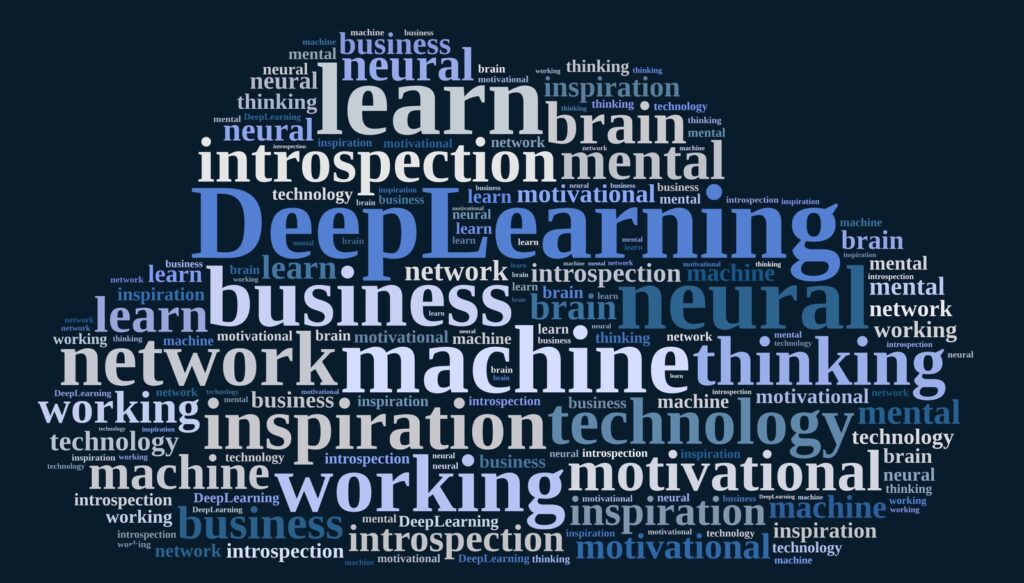
8.) Reinforcement Learning
Reinforcement learning is a research topic in data science that deals with algorithms that can learn on multiple levels from interactions with their environment.
This area of research is essential because it allows us to develop algorithms that can learn non-greedy approaches to decision-making, allowing businesses and companies to win in the long term compared to the short.
9.) Data Visualization
Data visualization is an excellent research topic in data science because it allows us to see our data in a way that is easy to understand.
Data visualization techniques can be used to create charts, graphs, and other visual representations of data.
This allows us to see the patterns and trends hidden in our data.
Data visualization is also used to communicate results to others.
This allows us to share our findings with others in a way that is easy to understand.
There are many ways to contribute to and learn about data visualization.
Some ways include attending conferences, reading papers, and contributing to open-source projects.
10.) Predictive Maintenance
Predictive maintenance is a hot topic in data science because it allows us to prevent failures before they happen.
This is done using data analytics to predict when a failure will occur.
This allows us to take corrective action before the failure actually happens.
While this sounds simple, avoiding false positives while keeping recall is challenging and an area wide open for advancement.
11.) Financial Analysis
Financial analysis is an older topic that has been around for a while but is still a great field where contributions can be felt.
Current researchers are focused on analyzing macroeconomic data to make better financial decisions.
This is done by analyzing the data to identify trends and patterns.
Financial analysts can use this information to make informed decisions about where to invest their money.
Financial analysis is also used to predict future economic trends.
This allows businesses and individuals to prepare for potential financial hardships and enable companies to be cash-heavy during good economic conditions.
Overall, financial analysis is a valuable tool for anyone looking to make better financial decisions.

12.) Image Recognition
Image recognition is one of the hottest topics in data science because it allows us to identify objects in images.
This is done using artificial intelligence algorithms that can learn from data and understand what objects you’re looking for.
This allows us to build models that can accurately recognize objects in images and video.
This is a valuable tool for businesses and individuals who want to be able to identify objects in images.
Think about security, identification, routing, traffic, etc.
Image Recognition has gained a ton of momentum recently – for a good reason.
13.) Fraud Detection
Fraud detection is a great topic in data science because it allows us to identify fraudulent activity before it happens.
This is done by analyzing data to look for patterns and trends that may be associated with the fraud.
Once our machine learning model recognizes some of these patterns in real time, it immediately detects fraud.
This allows us to take corrective action before the fraud actually happens.
Fraud detection is a valuable tool for anyone who wants to protect themselves from potential fraudulent activity.
14.) Web Scraping
Web scraping is a controversial topic in data science because it allows us to collect data from the web, which is usually data you do not own.
This is done by extracting data from websites using scraping tools that are usually custom-programmed.
This allows us to collect data that would otherwise be inaccessible.
For obvious reasons, web scraping is a unique tool – giving you data your competitors would have no chance of getting.
I think there is an excellent opportunity to create new and innovative ways to make scraping accessible for everyone, not just those who understand Selenium and Beautiful Soup.
15.) Social Media Analysis
Social media analysis is not new; many people have already created exciting and innovative algorithms to study this.
However, it is still a great data science research topic because it allows us to understand how people interact on social media.
This is done by analyzing data from social media platforms to look for insights, bots, and recent societal trends.
Once we understand these practices, we can use this information to improve our marketing efforts.
For example, if we know that a particular demographic prefers a specific type of content, we can create more content that appeals to them.
Social media analysis is also used to understand how people interact with brands on social media.
This allows businesses to understand better what their customers want and need.
Overall, social media analysis is valuable for anyone who wants to improve their marketing efforts or understand how customers interact with brands.

16.) GPU Computing
GPU computing is a fun new research topic in data science because it allows us to process data much faster than traditional CPUs .
Due to how GPUs are made, they’re incredibly proficient at intense matrix operations, outperforming traditional CPUs by very high margins.
While the computation is fast, the coding is still tricky.
There is an excellent research opportunity to bring these innovations to non-traditional modules, allowing data science to take advantage of GPU computing outside of deep learning.
17.) Quantum Computing
Quantum computing is a new research topic in data science and physics because it allows us to process data much faster than traditional computers.
It also opens the door to new types of data.
There are just some problems that can’t be solved utilizing outside of the classical computer.
For example, if you wanted to understand how a single atom moved around, a classical computer couldn’t handle this problem.
You’ll need to utilize a quantum computer to handle quantum mechanics problems.
This may be the “hottest” research topic on the planet right now, with some of the top researchers in computer science and physics worldwide working on it.
You could be too.
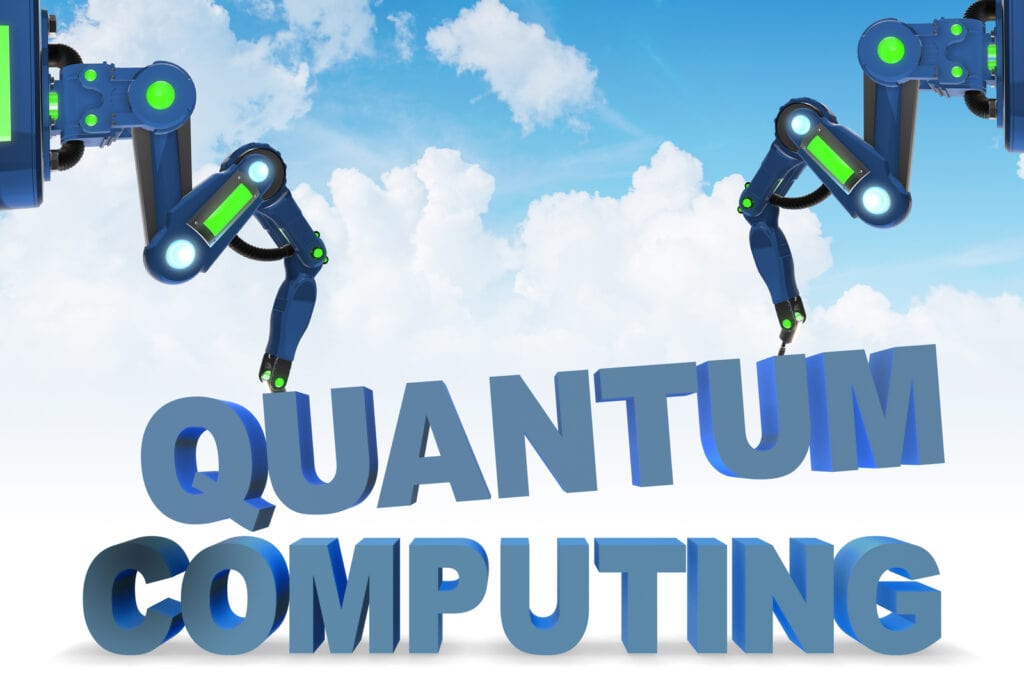
18.) Genomics
Genomics may be the only research topic that can compete with quantum computing regarding the “number of top researchers working on it.”
Genomics is a fantastic intersection of data science because it allows us to understand how genes work.
This is done by sequencing the DNA of different organisms to look for insights into our and other species.
Once we understand these patterns, we can use this information to improve our understanding of diseases and create new and innovative treatments for them.
Genomics is also used to study the evolution of different species.
Genomics is the future and a field begging for new and exciting research professionals to take it to the next step.
19.) Location-based services
Location-based services are an old and time-tested research topic in data science.
Since GPS and 4g cell phone reception became a thing, we’ve been trying to stay informed about how humans interact with their environment.
This is done by analyzing data from GPS tracking devices, cell phone towers, and Wi-Fi routers to look for insights into how humans interact.
Once we understand these practices, we can use this information to improve our geotargeting efforts, improve maps, find faster routes, and improve cohesion throughout a community.
Location-based services are used to understand the user, something every business could always use a little bit more of.
While a seemingly “stale” field, location-based services have seen a revival period with self-driving cars.

20.) Smart City Applications
Smart city applications are all the rage in data science research right now.
By harnessing the power of data, cities can become more efficient and sustainable.
But what exactly are smart city applications?
In short, they are systems that use data to improve city infrastructure and services.
This can include anything from traffic management and energy use to waste management and public safety.
Data is collected from various sources, including sensors, cameras, and social media.
It is then analyzed to identify tendencies and habits.
This information can make predictions about future needs and optimize city resources.
As more and more cities strive to become “smart,” the demand for data scientists with expertise in smart city applications is only growing.
21.) Internet Of Things (IoT)
The Internet of Things, or IoT, is exciting and new data science and sustainability research topic.
IoT is a network of physical objects embedded with sensors and connected to the internet.
These objects can include everything from alarm clocks to refrigerators; they’re all connected to the internet.
That means that they can share data with computers.
And that’s where data science comes in.
Data scientists are using IoT data to learn everything from how people use energy to how traffic flows through a city.
They’re also using IoT data to predict when an appliance will break down or when a road will be congested.
Really, the possibilities are endless.
With such a wide-open field, it’s easy to see why IoT is being researched by some of the top professionals in the world.

22.) Cybersecurity
Cybersecurity is a relatively new research topic in data science and in general, but it’s already garnering a lot of attention from businesses and organizations.
After all, with the increasing number of cyber attacks in recent years, it’s clear that we need to find better ways to protect our data.
While most of cybersecurity focuses on infrastructure, data scientists can leverage historical events to find potential exploits to protect their companies.
Sometimes, looking at a problem from a different angle helps, and that’s what data science brings to cybersecurity.
Also, data science can help to develop new security technologies and protocols.
As a result, cybersecurity is a crucial data science research area and one that will only become more important in the years to come.
23.) Blockchain
Blockchain is an incredible new research topic in data science for several reasons.
First, it is a distributed database technology that enables secure, transparent, and tamper-proof transactions.
Did someone say transmitting data?
This makes it an ideal platform for tracking data and transactions in various industries.
Second, blockchain is powered by cryptography, which not only makes it highly secure – but is a familiar foe for data scientists.
Finally, blockchain is still in its early stages of development, so there is much room for research and innovation.
As a result, blockchain is a great new research topic in data science that vows to revolutionize how we store, transmit and manage data.

24.) Sustainability
Sustainability is a relatively new research topic in data science, but it is gaining traction quickly.
To keep up with this demand, The Wharton School of the University of Pennsylvania has started to offer an MBA in Sustainability .
This demand isn’t shocking, and some of the reasons include the following:
Sustainability is an important issue that is relevant to everyone.
Datasets on sustainability are constantly growing and changing, making it an exciting challenge for data scientists.
There hasn’t been a “set way” to approach sustainability from a data perspective, making it an excellent opportunity for interdisciplinary research.
As data science grows, sustainability will likely become an increasingly important research topic.
25.) Educational Data
Education has always been a great topic for research, and with the advent of big data, educational data has become an even richer source of information.
By studying educational data, researchers can gain insights into how students learn, what motivates them, and what barriers these students may face.
Besides, data science can be used to develop educational interventions tailored to individual students’ needs.
Imagine being the researcher that helps that high schooler pass mathematics; what an incredible feeling.
With the increasing availability of educational data, data science has enormous potential to improve the quality of education.

26.) Politics
As data science continues to evolve, so does the scope of its applications.
Originally used primarily for business intelligence and marketing, data science is now applied to various fields, including politics.
By analyzing large data sets, political scientists (data scientists with a cooler name) can gain valuable insights into voting patterns, campaign strategies, and more.
Further, data science can be used to forecast election results and understand the effects of political events on public opinion.
With the wealth of data available, there is no shortage of research opportunities in this field.
As data science evolves, so does our understanding of politics and its role in our world.
27.) Cloud Technologies
Cloud technologies are a great research topic.
It allows for the outsourcing and sharing of computer resources and applications all over the internet.
This lets organizations save money on hardware and maintenance costs while providing employees access to the latest and greatest software and applications.
I believe there is an argument that AWS could be the greatest and most technologically advanced business ever built (Yes, I know it’s only part of the company).
Besides, cloud technologies can help improve team members’ collaboration by allowing them to share files and work on projects together in real-time.
As more businesses adopt cloud technologies, data scientists must stay up-to-date on the latest trends in this area.
By researching cloud technologies, data scientists can help organizations to make the most of this new and exciting technology.

28.) Robotics
Robotics has recently become a household name, and it’s for a good reason.
First, robotics deals with controlling and planning physical systems, an inherently complex problem.
Second, robotics requires various sensors and actuators to interact with the world, making it an ideal application for machine learning techniques.
Finally, robotics is an interdisciplinary field that draws on various disciplines, such as computer science, mechanical engineering, and electrical engineering.
As a result, robotics is a rich source of research problems for data scientists.
29.) HealthCare
Healthcare is an industry that is ripe for data-driven innovation.
Hospitals, clinics, and health insurance companies generate a tremendous amount of data daily.
This data can be used to improve the quality of care and outcomes for patients.
This is perfect timing, as the healthcare industry is undergoing a significant shift towards value-based care, which means there is a greater need than ever for data-driven decision-making.
As a result, healthcare is an exciting new research topic for data scientists.
There are many different ways in which data can be used to improve healthcare, and there is a ton of room for newcomers to make discoveries.

30.) Remote Work
There’s no doubt that remote work is on the rise.
In today’s global economy, more and more businesses are allowing their employees to work from home or anywhere else they can get a stable internet connection.
But what does this mean for data science? Well, for one thing, it opens up a whole new field of research.
For example, how does remote work impact employee productivity?
What are the best ways to manage and collaborate on data science projects when team members are spread across the globe?
And what are the cybersecurity risks associated with working remotely?
These are just a few of the questions that data scientists will be able to answer with further research.
So if you’re looking for a new topic to sink your teeth into, remote work in data science is a great option.
31.) Data-Driven Journalism
Data-driven journalism is an exciting new field of research that combines the best of both worlds: the rigor of data science with the creativity of journalism.
By applying data analytics to large datasets, journalists can uncover stories that would otherwise be hidden.
And telling these stories compellingly can help people better understand the world around them.
Data-driven journalism is still in its infancy, but it has already had a major impact on how news is reported.
In the future, it will only become more important as data becomes increasingly fluid among journalists.
It is an exciting new topic and research field for data scientists to explore.

32.) Data Engineering
Data engineering is a staple in data science, focusing on efficiently managing data.
Data engineers are responsible for developing and maintaining the systems that collect, process, and store data.
In recent years, there has been an increasing demand for data engineers as the volume of data generated by businesses and organizations has grown exponentially.
Data engineers must be able to design and implement efficient data-processing pipelines and have the skills to optimize and troubleshoot existing systems.
If you are looking for a challenging research topic that would immediately impact you worldwide, then improving or innovating a new approach in data engineering would be a good start.
33.) Data Curation
Data curation has been a hot topic in the data science community for some time now.
Curating data involves organizing, managing, and preserving data so researchers can use it.
Data curation can help to ensure that data is accurate, reliable, and accessible.
It can also help to prevent research duplication and to facilitate the sharing of data between researchers.
Data curation is a vital part of data science. In recent years, there has been an increasing focus on data curation, as it has become clear that it is essential for ensuring data quality.
As a result, data curation is now a major research topic in data science.
There are numerous books and articles on the subject, and many universities offer courses on data curation.
Data curation is an integral part of data science and will only become more important in the future.

34.) Meta-Learning
Meta-learning is gaining a ton of steam in data science. It’s learning how to learn.
So, if you can learn how to learn, you can learn anything much faster.
Meta-learning is mainly used in deep learning, as applications outside of this are generally pretty hard.
In deep learning, many parameters need to be tuned for a good model, and there’s usually a lot of data.
You can save time and effort if you can automatically and quickly do this tuning.
In machine learning, meta-learning can improve models’ performance by sharing knowledge between different models.
For example, if you have a bunch of different models that all solve the same problem, then you can use meta-learning to share the knowledge between them to improve the cluster (groups) overall performance.
I don’t know how anyone looking for a research topic could stay away from this field; it’s what the Terminator warned us about!
35.) Data Warehousing
A data warehouse is a system used for data analysis and reporting.
It is a central data repository created by combining data from multiple sources.
Data warehouses are often used to store historical data, such as sales data, financial data, and customer data.
This data type can be used to create reports and perform statistical analysis.
Data warehouses also store data that the organization is not currently using.
This type of data can be used for future research projects.
Data warehousing is an incredible research topic in data science because it offers a variety of benefits.
Data warehouses help organizations to save time and money by reducing the need for manual data entry.
They also help to improve the accuracy of reports and provide a complete picture of the organization’s performance.
Data warehousing feels like one of the weakest parts of the Data Science Technology Stack; if you want a research topic that could have a monumental impact – data warehousing is an excellent place to look.
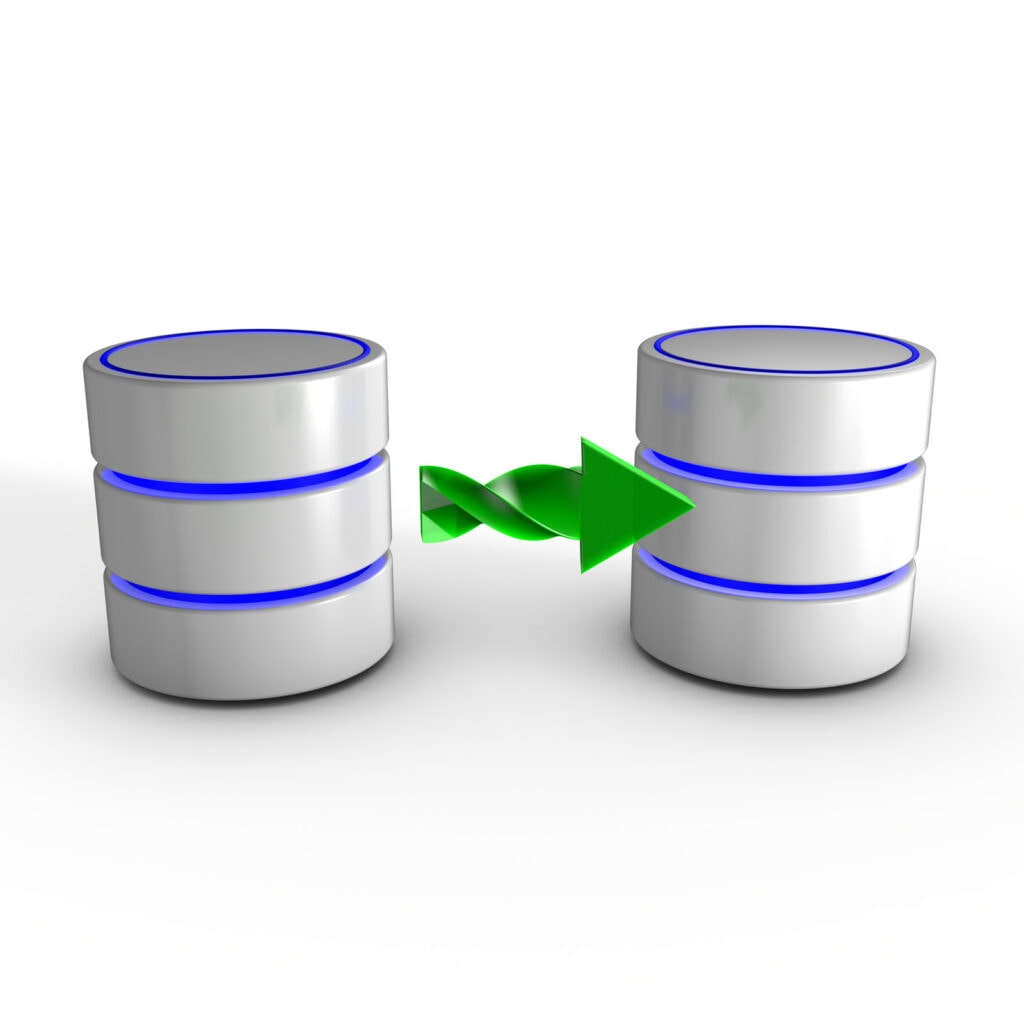
36.) Business Intelligence
Business intelligence aims to collect, process, and analyze data to help businesses make better decisions.
Business intelligence can improve marketing, sales, customer service, and operations.
It can also be used to identify new business opportunities and track competition.
BI is business and another tool in your company’s toolbox to continue dominating your area.
Data science is the perfect tool for business intelligence because it combines statistics, computer science, and machine learning.
Data scientists can use business intelligence to answer questions like, “What are our customers buying?” or “What are our competitors doing?” or “How can we increase sales?”
Business intelligence is a great way to improve your business’s bottom line and an excellent opportunity to dive deep into a well-respected research topic.
37.) Crowdsourcing
One of the newest areas of research in data science is crowdsourcing.
Crowdsourcing is a process of sourcing tasks or projects to a large group of people, typically via the internet.
This can be done for various purposes, such as gathering data, developing new algorithms, or even just for fun (think: online quizzes and surveys).
But what makes crowdsourcing so powerful is that it allows businesses and organizations to tap into a vast pool of talent and resources they wouldn’t otherwise have access to.
And with the rise of social media, it’s easier than ever to connect with potential crowdsource workers worldwide.
Imagine if you could effect that, finding innovative ways to improve how people work together.
That would have a huge effect.

Final Thoughts, Are These Research Topics In Data Science For You?
Thirty-seven different research topics in data science are a lot to take in, but we hope you found a research topic that interests you.
If not, don’t worry – there are plenty of other great topics to explore.
The important thing is to get started with your research and find ways to apply what you learn to real-world problems.
We wish you the best of luck as you begin your data science journey!
Other Data Science Articles
We love talking about data science; here are a couple of our favorite articles:
- Why Are You Interested In Data Science?
- Recent Posts
- How to Write a Compiler: Code Generation Explained [Master the Art Now] - May 20, 2024
- Are Software Engineers in USA Rich? [Discover the Surprising Truth!] - May 19, 2024
- Mastering Redragon Macro Software [Boost Efficiency Now] - May 19, 2024
Subscribe to the PwC Newsletter
Join the community, trending research, mambaout: do we really need mamba for vision.

For vision tasks, as image classification does not align with either characteristic, we hypothesize that Mamba is not necessary for this task; Detection and segmentation tasks are also not autoregressive, yet they adhere to the long-sequence characteristic, so we believe it is still worthwhile to explore Mamba's potential for these tasks.

Hunyuan-DiT: A Powerful Multi-Resolution Diffusion Transformer with Fine-Grained Chinese Understanding
For fine-grained language understanding, we train a Multimodal Large Language Model to refine the captions of the images.

Grounding DINO 1.5: Advance the "Edge" of Open-Set Object Detection
idea-research/grounding-dino-1.5-api • 16 May 2024
Empirical results demonstrate the effectiveness of Grounding DINO 1. 5, with the Grounding DINO 1. 5 Pro model attaining a 54. 3 AP on the COCO detection benchmark and a 55. 7 AP on the LVIS-minival zero-shot transfer benchmark, setting new records for open-set object detection.
How Far Are We to GPT-4V? Closing the Gap to Commercial Multimodal Models with Open-Source Suites
Compared to both open-source and proprietary models, InternVL 1. 5 shows competitive performance, achieving state-of-the-art results in 8 of 18 benchmarks.

A decoder-only foundation model for time-series forecasting

Motivated by recent advances in large language models for Natural Language Processing (NLP), we design a time-series foundation model for forecasting whose out-of-the-box zero-shot performance on a variety of public datasets comes close to the accuracy of state-of-the-art supervised forecasting models for each individual dataset.
How Far Are We From AGI
ulab-uiuc/agi-survey • 16 May 2024
The evolution of artificial intelligence (AI) has profoundly impacted human society, driving significant advancements in multiple sectors.
AniTalker: Animate Vivid and Diverse Talking Faces through Identity-Decoupled Facial Motion Encoding
The paper introduces AniTalker, an innovative framework designed to generate lifelike talking faces from a single portrait.

Sakuga-42M Dataset: Scaling Up Cartoon Research
zhenglinpan/SakugaDataset • 13 May 2024
Can we harness the success of the scaling paradigm to benefit cartoon research?

Lumina-T2X: Transforming Text into Any Modality, Resolution, and Duration via Flow-based Large Diffusion Transformers
Sora unveils the potential of scaling Diffusion Transformer for generating photorealistic images and videos at arbitrary resolutions, aspect ratios, and durations, yet it still lacks sufficient implementation details.
KAN: Kolmogorov-Arnold Networks
Inspired by the Kolmogorov-Arnold representation theorem, we propose Kolmogorov-Arnold Networks (KANs) as promising alternatives to Multi-Layer Perceptrons (MLPs).
Machine Intelligence
Google is at the forefront of innovation in Machine Intelligence, with active research exploring virtually all aspects of machine learning, including deep learning and more classical algorithms. Exploring theory as well as application, much of our work on language, speech, translation, visual processing, ranking and prediction relies on Machine Intelligence. In all of those tasks and many others, we gather large volumes of direct or indirect evidence of relationships of interest, applying learning algorithms to understand and generalize.
Machine Intelligence at Google raises deep scientific and engineering challenges, allowing us to contribute to the broader academic research community through technical talks and publications in major conferences and journals. Contrary to much of current theory and practice, the statistics of the data we observe shifts rapidly, the features of interest change as well, and the volume of data often requires enormous computation capacity. When learning systems are placed at the core of interactive services in a fast changing and sometimes adversarial environment, combinations of techniques including deep learning and statistical models need to be combined with ideas from control and game theory.
Recent Publications
Some of our teams.
Algorithms & optimization
Applied science
Climate and sustainability
Graph mining
Impact-Driven Research, Innovation and Moonshots
Learning theory
Market algorithms
Operations research
Security, privacy and abuse
System performance
We're always looking for more talented, passionate people.

The Future of AI Research: 20 Thesis Ideas for Undergraduate Students in Machine Learning and Deep Learning for 2023!
A comprehensive guide for crafting an original and innovative thesis in the field of ai..
By Aarafat Islam on 2023-01-11
“The beauty of machine learning is that it can be applied to any problem you want to solve, as long as you can provide the computer with enough examples.” — Andrew Ng
This article provides a list of 20 potential thesis ideas for an undergraduate program in machine learning and deep learning in 2023. Each thesis idea includes an introduction , which presents a brief overview of the topic and the research objectives . The ideas provided are related to different areas of machine learning and deep learning, such as computer vision, natural language processing, robotics, finance, drug discovery, and more. The article also includes explanations, examples, and conclusions for each thesis idea, which can help guide the research and provide a clear understanding of the potential contributions and outcomes of the proposed research. The article also emphasized the importance of originality and the need for proper citation in order to avoid plagiarism.
1. Investigating the use of Generative Adversarial Networks (GANs) in medical imaging: A deep learning approach to improve the accuracy of medical diagnoses.
Introduction: Medical imaging is an important tool in the diagnosis and treatment of various medical conditions. However, accurately interpreting medical images can be challenging, especially for less experienced doctors. This thesis aims to explore the use of GANs in medical imaging, in order to improve the accuracy of medical diagnoses.
2. Exploring the use of deep learning in natural language generation (NLG): An analysis of the current state-of-the-art and future potential.
Introduction: Natural language generation is an important field in natural language processing (NLP) that deals with creating human-like text automatically. Deep learning has shown promising results in NLP tasks such as machine translation, sentiment analysis, and question-answering. This thesis aims to explore the use of deep learning in NLG and analyze the current state-of-the-art models, as well as potential future developments.
3. Development and evaluation of deep reinforcement learning (RL) for robotic navigation and control.
Introduction: Robotic navigation and control are challenging tasks, which require a high degree of intelligence and adaptability. Deep RL has shown promising results in various robotics tasks, such as robotic arm control, autonomous navigation, and manipulation. This thesis aims to develop and evaluate a deep RL-based approach for robotic navigation and control and evaluate its performance in various environments and tasks.
4. Investigating the use of deep learning for drug discovery and development.
Introduction: Drug discovery and development is a time-consuming and expensive process, which often involves high failure rates. Deep learning has been used to improve various tasks in bioinformatics and biotechnology, such as protein structure prediction and gene expression analysis. This thesis aims to investigate the use of deep learning for drug discovery and development and examine its potential to improve the efficiency and accuracy of the drug development process.
5. Comparison of deep learning and traditional machine learning methods for anomaly detection in time series data.
Introduction: Anomaly detection in time series data is a challenging task, which is important in various fields such as finance, healthcare, and manufacturing. Deep learning methods have been used to improve anomaly detection in time series data, while traditional machine learning methods have been widely used as well. This thesis aims to compare deep learning and traditional machine learning methods for anomaly detection in time series data and examine their respective strengths and weaknesses.
Photo by Joanna Kosinska on Unsplash
6. Use of deep transfer learning in speech recognition and synthesis.
Introduction: Speech recognition and synthesis are areas of natural language processing that focus on converting spoken language to text and vice versa. Transfer learning has been widely used in deep learning-based speech recognition and synthesis systems to improve their performance by reusing the features learned from other tasks. This thesis aims to investigate the use of transfer learning in speech recognition and synthesis and how it improves the performance of the system in comparison to traditional methods.
7. The use of deep learning for financial prediction.
Introduction: Financial prediction is a challenging task that requires a high degree of intelligence and adaptability, especially in the field of stock market prediction. Deep learning has shown promising results in various financial prediction tasks, such as stock price prediction and credit risk analysis. This thesis aims to investigate the use of deep learning for financial prediction and examine its potential to improve the accuracy of financial forecasting.
8. Investigating the use of deep learning for computer vision in agriculture.
Introduction: Computer vision has the potential to revolutionize the field of agriculture by improving crop monitoring, precision farming, and yield prediction. Deep learning has been used to improve various computer vision tasks, such as object detection, semantic segmentation, and image classification. This thesis aims to investigate the use of deep learning for computer vision in agriculture and examine its potential to improve the efficiency and accuracy of crop monitoring and precision farming.
9. Development and evaluation of deep learning models for generative design in engineering and architecture.
Introduction: Generative design is a powerful tool in engineering and architecture that can help optimize designs and reduce human error. Deep learning has been used to improve various generative design tasks, such as design optimization and form generation. This thesis aims to develop and evaluate deep learning models for generative design in engineering and architecture and examine their potential to improve the efficiency and accuracy of the design process.
10. Investigating the use of deep learning for natural language understanding.
Introduction: Natural language understanding is a complex task of natural language processing that involves extracting meaning from text. Deep learning has been used to improve various NLP tasks, such as machine translation, sentiment analysis, and question-answering. This thesis aims to investigate the use of deep learning for natural language understanding and examine its potential to improve the efficiency and accuracy of natural language understanding systems.
Photo by UX Indonesia on Unsplash
11. Comparing deep learning and traditional machine learning methods for image compression.
Introduction: Image compression is an important task in image processing and computer vision. It enables faster data transmission and storage of image files. Deep learning methods have been used to improve image compression, while traditional machine learning methods have been widely used as well. This thesis aims to compare deep learning and traditional machine learning methods for image compression and examine their respective strengths and weaknesses.
12. Using deep learning for sentiment analysis in social media.
Introduction: Sentiment analysis in social media is an important task that can help businesses and organizations understand their customers’ opinions and feedback. Deep learning has been used to improve sentiment analysis in social media, by training models on large datasets of social media text. This thesis aims to use deep learning for sentiment analysis in social media, and evaluate its performance against traditional machine learning methods.
13. Investigating the use of deep learning for image generation.
Introduction: Image generation is a task in computer vision that involves creating new images from scratch or modifying existing images. Deep learning has been used to improve various image generation tasks, such as super-resolution, style transfer, and face generation. This thesis aims to investigate the use of deep learning for image generation and examine its potential to improve the quality and diversity of generated images.
14. Development and evaluation of deep learning models for anomaly detection in cybersecurity.
Introduction: Anomaly detection in cybersecurity is an important task that can help detect and prevent cyber-attacks. Deep learning has been used to improve various anomaly detection tasks, such as intrusion detection and malware detection. This thesis aims to develop and evaluate deep learning models for anomaly detection in cybersecurity and examine their potential to improve the efficiency and accuracy of cybersecurity systems.
15. Investigating the use of deep learning for natural language summarization.
Introduction: Natural language summarization is an important task in natural language processing that involves creating a condensed version of a text that preserves its main meaning. Deep learning has been used to improve various natural language summarization tasks, such as document summarization and headline generation. This thesis aims to investigate the use of deep learning for natural language summarization and examine its potential to improve the efficiency and accuracy of natural language summarization systems.
Photo by Windows on Unsplash
16. Development and evaluation of deep learning models for facial expression recognition.
Introduction: Facial expression recognition is an important task in computer vision and has many practical applications, such as human-computer interaction, emotion recognition, and psychological studies. Deep learning has been used to improve facial expression recognition, by training models on large datasets of images. This thesis aims to develop and evaluate deep learning models for facial expression recognition and examine their performance against traditional machine learning methods.
17. Investigating the use of deep learning for generative models in music and audio.
Introduction: Music and audio synthesis is an important task in audio processing, which has many practical applications, such as music generation and speech synthesis. Deep learning has been used to improve generative models for music and audio, by training models on large datasets of audio data. This thesis aims to investigate the use of deep learning for generative models in music and audio and examine its potential to improve the quality and diversity of generated audio.
18. Study the comparison of deep learning models with traditional algorithms for anomaly detection in network traffic.
Introduction: Anomaly detection in network traffic is an important task that can help detect and prevent cyber-attacks. Deep learning models have been used for this task, and traditional methods such as clustering and rule-based systems are widely used as well. This thesis aims to compare deep learning models with traditional algorithms for anomaly detection in network traffic and analyze the trade-offs between the models in terms of accuracy and scalability.
19. Investigating the use of deep learning for improving recommender systems.
Introduction: Recommender systems are widely used in many applications such as online shopping, music streaming, and movie streaming. Deep learning has been used to improve the performance of recommender systems, by training models on large datasets of user-item interactions. This thesis aims to investigate the use of deep learning for improving recommender systems and compare its performance with traditional content-based and collaborative filtering approaches.
20. Development and evaluation of deep learning models for multi-modal data analysis.
Introduction: Multi-modal data analysis is the task of analyzing and understanding data from multiple sources such as text, images, and audio. Deep learning has been used to improve multi-modal data analysis, by training models on large datasets of multi-modal data. This thesis aims to develop and evaluate deep learning models for multi-modal data analysis and analyze their potential to improve performance in comparison to single-modal models.
I hope that this article has provided you with a useful guide for your thesis research in machine learning and deep learning. Remember to conduct a thorough literature review and to include proper citations in your work, as well as to be original in your research to avoid plagiarism. I wish you all the best of luck with your thesis and your research endeavors!
Continue Learning
The depth i: stereo calibration and rectification, using chains and agents for llm application development.
Step-by-step guide to using chains and agents in LangChain
Amazon BedRock — Build Generative AI at Scale
Best practices for ai professional headshots: mastering your visual brand, art generating ai, prompt engineering: how to turn your words into works of art.
Suggestions or feedback?
MIT News | Massachusetts Institute of Technology
Machine learning.
- Social justice
- Black holes
- Classes and programs
Departments
- Aeronautics and Astronautics
- Brain and Cognitive Sciences
- Architecture
- Political Science
- Mechanical Engineering
Centers, Labs, & Programs
- Abdul Latif Jameel Poverty Action Lab (J-PAL)
- Picower Institute for Learning and Memory
- Lincoln Laboratory
- School of Architecture + Planning
- School of Engineering
- School of Humanities, Arts, and Social Sciences
- Sloan School of Management
- School of Science
- MIT Schwarzman College of Computing
Download RSS feed: News Articles / In the Media / Audio

Scientists use generative AI to answer complex questions in physics
A new technique that can automatically classify phases of physical systems could help scientists investigate novel materials.
May 16, 2024
Read full story →

Using ideas from game theory to improve the reliability of language models
A new “consensus game,” developed by MIT CSAIL researchers, elevates AI’s text comprehension and generation skills.
May 14, 2024

A better way to control shape-shifting soft robots
A new algorithm learns to squish, bend, or stretch a robot’s entire body to accomplish diverse tasks like avoiding obstacles or retrieving items.
May 10, 2024

Exploring the mysterious alphabet of sperm whales
MIT CSAIL and Project CETI researchers reveal complex communication patterns in sperm whales, deepening our understanding of animal language systems.
May 7, 2024

President Sally Kornbluth and OpenAI CEO Sam Altman discuss the future of AI
The conversation in Kresge Auditorium touched on the promise and perils of the rapidly evolving technology.
May 6, 2024

Creating bespoke programming languages for efficient visual AI systems
Associate Professor Jonathan Ragan-Kelley optimizes how computer graphics and images are processed for the hardware of today and tomorrow.
May 3, 2024
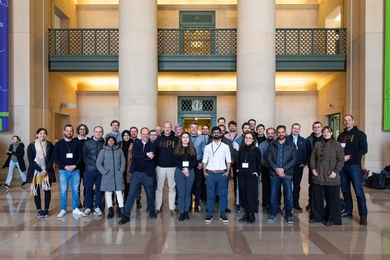
HPI-MIT design research collaboration creates powerful teams
Together, the Hasso Plattner Institute and MIT are working toward novel solutions to the world’s problems as part of the Designing for Sustainability research program.
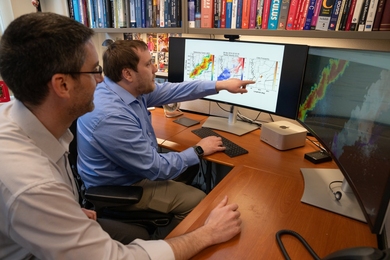
An AI dataset carves new paths to tornado detection
TorNet, a public artificial intelligence dataset, could help models reveal when and why tornadoes form, improving forecasters' ability to issue warnings.
April 29, 2024

MIT faculty, instructors, students experiment with generative AI in teaching and learning
At MIT’s Festival of Learning 2024, panelists stressed the importance of developing critical thinking skills while leveraging technologies like generative AI.

Three from MIT awarded 2024 Guggenheim Fellowships
MIT professors Roger Levy, Tracy Slatyer, and Martin Wainwright appointed to the 2024 class of “trail-blazing fellows.”
April 26, 2024

Mapping the brain pathways of visual memorability
For the first time, researchers use a combination of MEG and fMRI to map the spatio-temporal human brain dynamics of a visual image being recognized.
April 23, 2024

This tiny chip can safeguard user data while enabling efficient computing on a smartphone
Researchers have developed a security solution for power-hungry AI models that offers protection against two common attacks.

Researchers detect a new molecule in space
Such discoveries help researchers better understand the development of molecular complexity in space during star formation.
April 22, 2024

To build a better AI helper, start by modeling the irrational behavior of humans
A new technique can be used to predict the actions of human or AI agents who behave suboptimally while working toward unknown goals.
April 19, 2024

Using deep learning to image the Earth’s planetary boundary layer
Lincoln Laboratory researchers are using AI to get a better picture of the atmospheric layer closest to Earth's surface. Their techniques could improve weather and drought prediction.
April 18, 2024
Massachusetts Institute of Technology 77 Massachusetts Avenue, Cambridge, MA, USA
- Map (opens in new window)
- Events (opens in new window)
- People (opens in new window)
- Careers (opens in new window)
- Accessibility
- Social Media Hub
- MIT on Facebook
- MIT on YouTube
- MIT on Instagram
Thank you for visiting nature.com. You are using a browser version with limited support for CSS. To obtain the best experience, we recommend you use a more up to date browser (or turn off compatibility mode in Internet Explorer). In the meantime, to ensure continued support, we are displaying the site without styles and JavaScript.
- View all journals
- Explore content
- About the journal
- Publish with us
- Sign up for alerts
Machine learning articles within Nature
World View | 14 May 2024
Why mathematics is set to be revolutionized by AI
Cheap data and the absence of coincidences make maths an ideal testing ground for AI-assisted discovery — but only humans will be able to tell good conjectures from bad ones.
- Thomas Fink
News Feature | 14 May 2024
How does ChatGPT ‘think’? Psychology and neuroscience crack open AI large language models
Researchers are striving to reverse-engineer artificial intelligence and scan the ‘brains’ of LLMs to see what they are doing, how and why.
- Matthew Hutson
News Q&A | 09 May 2024
The US Congress is taking on AI — this computer scientist is helping
Kiri Wagstaff, who temporarily shelved her academic career to provide advice on federal AI legislation, talks about life inside the halls of power.
- Nicola Jones
Article | 08 May 2024
Accurate structure prediction of biomolecular interactions with AlphaFold 3
- Josh Abramson
- , Jonas Adler
- & John M. Jumper
Research Briefing | 08 May 2024
‘Ghost roads’ could be the biggest direct threat to tropical forests
By using volunteers to map roads in forests across Borneo, Sumatra and New Guinea, an innovative study shows that existing maps of the Asia-Pacific region are rife with errors. It also reveals that unmapped roads are extremely common — up to seven times more abundant than mapped ones. Such ‘ghost roads’ are promoting illegal logging, mining, wildlife poaching and deforestation in some of the world’s biologically richest ecosystems.
News | 08 May 2024
Major AlphaFold upgrade offers boost for drug discovery
Latest version of the AI models how proteins interact with other molecules — but DeepMind restricts access to the tool.
- Ewen Callaway
News | 03 May 2024
Who’s making chips for AI? Chinese manufacturers lag behind US tech giants
Researchers in China say they are finding themselves five to ten years behind their US counterparts as export restrictions bite.
- Jonathan O'Callaghan
News | 29 April 2024
‘ChatGPT for CRISPR’ creates new gene-editing tools
Some of the AI-designed gene editors could be more versatile than those found in nature.
News Feature | 23 April 2024
Lethal AI weapons are here: how can we control them?
Autonomous weapons guided by artificial intelligence are already in use. Researchers, legal experts and ethicists are struggling with what should be allowed on the battlefield.
Comment | 22 April 2024
Will AI accelerate or delay the race to net-zero emissions?
As artificial intelligence transforms the global economy, researchers need to explore scenarios to assess how it can help, rather than harm, the climate.
- , Jonathan Koomey
- & Eric Horvitz
Outlook | 18 April 2024
AI’s keen diagnostic eye
Powered by deep-learning algorithms, artificial intelligence systems could replace agents such as chemicals currently used to augment medical scans.
- Neil Savage
Nature Video | 17 April 2024
AI and robotics demystify the workings of a fly's wing
New research unveils the workings of one of the most complex bio-mechanical structures in the natural world
News | 17 April 2024
AI traces mysterious metastatic cancers to their source
Algorithm examines images of metastatic cells to identify the location of the primary tumour.
- Smriti Mallapaty
News | 15 April 2024
AI now beats humans at basic tasks — new benchmarks are needed, says major report
Stanford University’s 2024 AI Index charts the meteoric rise of artificial-intelligence tools.
News | 10 April 2024
Is ChatGPT corrupting peer review? Telltale words hint at AI use
A study of review reports identifies dozens of adjectives that could indicate text written with the help of chatbots.
- Dalmeet Singh Chawla
Correspondence | 09 April 2024
How to break big tech’s stranglehold on AI in academia
- Michał Woźniak
- & Paweł Ksieniewicz
Comment | 09 April 2024
AI can help to tailor drugs for Africa — but Africans should lead the way
Computational models that require very little data could transform biomedical and drug development research in Africa, as long as infrastructure, trained staff and secure databases are available.
- Gemma Turon
- , Mathew Njoroge
- & Kelly Chibale
Technology Feature | 08 April 2024
‘Without these tools, I’d be lost’: how generative AI aids in accessibility
A rush to place barriers around the use of artificial intelligence in academia could disproportionately affect those who stand to benefit most.
- Amanda Heidt
Career Column | 08 April 2024
Three ways ChatGPT helps me in my academic writing
Generative AI can be a valuable aid in writing, editing and peer review – if you use it responsibly, says Dritjon Gruda.
- Dritjon Gruda
Career Feature | 08 April 2024
Ready or not, AI is coming to science education — and students have opinions
As educators debate whether it’s even possible to use AI safely in research and education, students are taking a role in shaping its responsible use.
- Sarah Wells
Research Briefing | 03 April 2024
Artificial intelligence can provide accurate forecasts of extreme floods at global scale
Anthropogenic climate change is accelerating the hydrological cycle, causing an increase in the risk of flood-related disasters. A system that uses artificial intelligence allows the creation of reliable, global river flood forecasts, even in places where accurate local data are not available.
News Feature | 26 March 2024
How AI is improving climate forecasts
Researchers are using various machine-learning strategies to speed up climate modelling, reduce its energy costs and hopefully improve accuracy.
- Carissa Wong
News | 21 March 2024
Google AI could soon use a person’s cough to diagnose disease
Machine-learning system trained on millions of human audio clips shows promise for detecting COVID-19 and tuberculosis.
- Mariana Lenharo
Correspondence | 19 March 2024
Three reasons why AI doesn’t model human language
- Johan J. Bolhuis
- , Stephen Crain
- & Andrea Moro
News | 19 March 2024
‘A landmark moment’: scientists use AI to design antibodies from scratch
Modified protein-design tool could make it easier to tackle challenging drug targets — but AI antibodies are still a long way from reaching the clinic.
News Feature | 19 March 2024
AI image generators often give racist and sexist results: can they be fixed?
Researchers are tracing sources of racial and gender bias in images generated by artificial intelligence, and making efforts to fix them.
News & Views | 18 March 2024
Can lessons from infants solve the problems of data-greedy AI?
Words and images experienced by an infant wearing sensors during their daily life have led to efficient machine learning, pointing to the power of multimodal training signals and to the potentially exploitable statistics of real-life experience.
- Linda B. Smith
Research Briefing | 18 March 2024
‘Bandit’ algorithms help chemists to discover generally applicable conditions for reactions
In organic chemistry, finding conditions that enable a broad range of compounds to undergo a particular type of reaction is highly desirable. However, conventional methods for doing so consume a lot of time and reagents. A machine-learning method has been developed that overcomes these problems.
Nature Index | 13 March 2024
How AI is being used to accelerate clinical trials
From study design to patient recruitment, researchers are investigating ways that technology could speed up the process.
Four change-makers seek impact in medical research
Bringing fresh perspectives to long-standing health challenges, these scientists are using techniques such as big-data analytics and AI to push the field.
- & Sandy Ong
News | 13 March 2024
Chatbot AI makes racist judgements on the basis of dialect
Some large language models harbour hidden biases that cannot be removed using standard methods.
- Elizabeth Gibney
Correspondence | 12 March 2024
Embrace AI to break down barriers in publishing for people who aren’t fluent in English
- Charles Morphy D. Santos
- & João Paulo Gois
News | 08 March 2024
Could AI-designed proteins be weaponized? Scientists lay out safety guidelines
AI tools that can come up with protein structures at the push of a button should be used safely and ethically, say researchers in the field.
News Explainer | 07 March 2024
AI-generated images and video are here: how could they shape research?
Scientists are already using image-generating models to jazz up papers and presentations. But some say these tools could harm research.
Editorial | 06 March 2024
Why scientists trust AI too much — and what to do about it
Some researchers see superhuman qualities in artificial intelligence. All scientists need to be alert to the risks this creates.
World View | 05 March 2024
Here’s what many digital tools for chronic pain are doing wrong
To address the chronic-pain crisis, digital health technologies must break out of their silos and become integrative and holistic.
- Benjamin Lipp
News Explainer | 28 February 2024
Is ChatGPT making scientists hyper-productive? The highs and lows of using AI
Large language models are transforming scientific writing and publishing. But the productivity boost that these tools bring could have a downside.
- McKenzie Prillaman
Article 26 February 2024 | Open Access
Automated model building and protein identification in cryo-EM maps
ModelAngelo builds atomic models and identifies proteins with unknown sequences in cryo-EM maps.
- Kiarash Jamali
- , Lukas Käll
- & Sjors H. W. Scheres
Correspondence | 20 February 2024
Stockholm declaration on AI ethics: why others should sign
- Ross D. King
- , Teresa Scassa
- & Hiroaki Kitano
World View | 20 February 2024
Generative AI’s environmental costs are soaring — and mostly secret
First-of-its-kind US bill would address the environmental costs of the technology, but there’s a long way to go.
- Kate Crawford
News Explainer | 16 February 2024

What the EU’s tough AI law means for research and ChatGPT
The EU AI Act is the world’s first major legislation on artificial intelligence and strictly regulates general-purpose models.
News Explainer | 12 February 2024
How journals are fighting back against a wave of questionable images
Publishers are deploying AI-based tools to detect suspicious images, but generative AI threatens their efforts.
News | 12 February 2024
Apple Vision Pro: what does it mean for scientists?
The headset opens up possibilities in accessibility and medical research — and raises concerns about human behaviour.
News | 06 February 2024
AI chatbot shows surprising talent for predicting chemical properties and reactions
Researchers lightly tweak ChatGPT-like system to offer chemistry insight.
- Davide Castelvecchi
Career Column | 05 February 2024
‘Obviously ChatGPT’ — how reviewers accused me of scientific fraud
A journal reviewer accused Lizzie Wolkovich of using ChatGPT to write a manuscript. She hadn’t — but her paper was rejected anyway.
- E. M. Wolkovich
News | 05 February 2024
First passages of rolled-up Herculaneum scroll revealed
Researchers used artificial intelligence to decipher the text of 2,000-year-old charred papyrus scripts, unveiling musings on music and capers.
- Jo Marchant
Career Column | 01 February 2024
In the AI science boom, beware: your results are only as good as your data
Machine-learning systems are voracious data consumers — but trustworthy results require more vetting both before and after publication.
- Hunter Moseley
News | 01 February 2024
This AI learnt language by seeing the world through a baby’s eyes
A neural network that taught itself to recognize objects using the filmed experiences of a single infant could offer new insights into how humans learn.
Editorial | 31 January 2024
How can scientists make the most of the public’s trust in them?
Researchers have a part to play in addressing concerns about government interference in science.
Correspondence | 30 January 2024
Reaching carbon neutrality requires energy-efficient training of AI
Browse broader subjects
- Computational biology and bioinformatics
Quick links
- Explore articles by subject
- Guide to authors
- Editorial policies

Machine Learning
- Reports substantive results on a wide range of learning methods applied to various learning problems.
- Provides robust support through empirical studies, theoretical analysis, or comparison to psychological phenomena.
- Demonstrates how to apply learning methods to solve significant application problems.
- Improves how machine learning research is conducted.
- Prioritizes verifiable and replicable supporting evidence in all published papers.
- Hendrik Blockeel

Latest issue
Volume 113, Issue 6
Latest articles
Comadout—a robust outlier detection algorithm based on comad.
- Andreas Lohrer
- Daniyal Kazempour
- Peer Kröger

Finite-time error bounds for Greedy-GQ
- Shaofeng Zou

SWoTTeD : an extension of tensor decomposition to temporal phenotyping
- Thomas Guyet
- Etienne Audureau

Semantic-enhanced graph neural networks with global context representation
- Youcheng Qian

Explaining Siamese networks in few-shot learning
- Andrea Fedele
- Riccardo Guidotti
- Dino Pedreschi

Journal updates
Cfp: discovery science 2023.
Submission Deadline: March 4, 2024
Guest Editors: Rita P. Ribeiro, Albert Bifet, Ana Carolina Lorena
CfP: IJCLR Learning and reasoning
Call for papers: conformal prediction and distribution-free uncertainty quantification.
Submission Deadline: January 7th, 2024
Guest Editors: Henrik Boström, Eyke Hüllermeier, Ulf Johansson, Khuong An Nguyen, Aaditya Ramdas
Call for Papers: DSAA 2024 Journal Track with Machine Learning Journal
Guest Editors: Longbing Cao, David C. Anastasiu, Qi Zhang, Xiaolin Huang,
Journal information
- ACM Digital Library
- Current Contents/Engineering, Computing and Technology
- EI Compendex
- Google Scholar
- Japanese Science and Technology Agency (JST)
- Mathematical Reviews
- OCLC WorldCat Discovery Service
- Science Citation Index Expanded (SCIE)
- TD Net Discovery Service
- UGC-CARE List (India)
Rights and permissions
Editorial policies
© Springer Science+Business Media LLC, part of Springer Nature
- Find a journal
- Publish with us
- Track your research
Help | Advanced Search
Computer Science > Machine Learning
Title: the top 10 topics in machine learning revisited: a quantitative meta-study.
Abstract: Which topics of machine learning are most commonly addressed in research? This question was initially answered in 2007 by doing a qualitative survey among distinguished researchers. In our study, we revisit this question from a quantitative perspective. Concretely, we collect 54K abstracts of papers published between 2007 and 2016 in leading machine learning journals and conferences. We then use machine learning in order to determine the top 10 topics in machine learning. We not only include models, but provide a holistic view across optimization, data, features, etc. This quantitative approach allows reducing the bias of surveys. It reveals new and up-to-date insights into what the 10 most prolific topics in machine learning research are. This allows researchers to identify popular topics as well as new and rising topics for their research.
Submission history
Access paper:.
- Other Formats
References & Citations
- Google Scholar
- Semantic Scholar
DBLP - CS Bibliography
Bibtex formatted citation.
Bibliographic and Citation Tools
Code, data and media associated with this article, recommenders and search tools.
- Institution
arXivLabs: experimental projects with community collaborators
arXivLabs is a framework that allows collaborators to develop and share new arXiv features directly on our website.
Both individuals and organizations that work with arXivLabs have embraced and accepted our values of openness, community, excellence, and user data privacy. arXiv is committed to these values and only works with partners that adhere to them.
Have an idea for a project that will add value for arXiv's community? Learn more about arXivLabs .
machine learning Recently Published Documents
Total documents.
- Latest Documents
- Most Cited Documents
- Contributed Authors
- Related Sources
- Related Keywords
An explainable machine learning model for identifying geographical origins of sea cucumber Apostichopus japonicus based on multi-element profile
A comparison of machine learning- and regression-based models for predicting ductility ratio of rc beam-column joints, alexa, is this a historical record.
Digital transformation in government has brought an increase in the scale, variety, and complexity of records and greater levels of disorganised data. Current practices for selecting records for transfer to The National Archives (TNA) were developed to deal with paper records and are struggling to deal with this shift. This article examines the background to the problem and outlines a project that TNA undertook to research the feasibility of using commercially available artificial intelligence tools to aid selection. The project AI for Selection evaluated a range of commercial solutions varying from off-the-shelf products to cloud-hosted machine learning platforms, as well as a benchmarking tool developed in-house. Suitability of tools depended on several factors, including requirements and skills of transferring bodies as well as the tools’ usability and configurability. This article also explores questions around trust and explainability of decisions made when using AI for sensitive tasks such as selection.
Automated Text Classification of Maintenance Data of Higher Education Buildings Using Text Mining and Machine Learning Techniques
Data-driven analysis and machine learning for energy prediction in distributed photovoltaic generation plants: a case study in queensland, australia, modeling nutrient removal by membrane bioreactor at a sewage treatment plant using machine learning models, big five personality prediction based in indonesian tweets using machine learning methods.
<span lang="EN-US">The popularity of social media has drawn the attention of researchers who have conducted cross-disciplinary studies examining the relationship between personality traits and behavior on social media. Most current work focuses on personality prediction analysis of English texts, but Indonesian has received scant attention. Therefore, this research aims to predict user’s personalities based on Indonesian text from social media using machine learning techniques. This paper evaluates several machine learning techniques, including <a name="_Hlk87278444"></a>naive Bayes (NB), K-nearest neighbors (KNN), and support vector machine (SVM), based on semantic features including emotion, sentiment, and publicly available Twitter profile. We predict the personality based on the big five personality model, the most appropriate model for predicting user personality in social media. We examine the relationships between the semantic features and the Big Five personality dimensions. The experimental results indicate that the Big Five personality exhibit distinct emotional, sentimental, and social characteristics and that SVM outperformed NB and KNN for Indonesian. In addition, we observe several terms in Indonesian that specifically refer to each personality type, each of which has distinct emotional, sentimental, and social features.</span>
Compressive strength of concrete with recycled aggregate; a machine learning-based evaluation
Temperature prediction of flat steel box girders of long-span bridges utilizing in situ environmental parameters and machine learning, computer-assisted cohort identification in practice.
The standard approach to expert-in-the-loop machine learning is active learning, where, repeatedly, an expert is asked to annotate one or more records and the machine finds a classifier that respects all annotations made until that point. We propose an alternative approach, IQRef , in which the expert iteratively designs a classifier and the machine helps him or her to determine how well it is performing and, importantly, when to stop, by reporting statistics on a fixed, hold-out sample of annotated records. We justify our approach based on prior work giving a theoretical model of how to re-use hold-out data. We compare the two approaches in the context of identifying a cohort of EHRs and examine their strengths and weaknesses through a case study arising from an optometric research problem. We conclude that both approaches are complementary, and we recommend that they both be employed in conjunction to address the problem of cohort identification in health research.
Export Citation Format
Share document.
- Warning : Invalid argument supplied for foreach() in /home/customer/www/opendatascience.com/public_html/wp-includes/nav-menu.php on line 95 Warning : array_merge(): Expected parameter 2 to be an array, null given in /home/customer/www/opendatascience.com/public_html/wp-includes/nav-menu.php on line 102
- ODSC EUROPE
- AI+ Training
- Speak at ODSC

- Data Analytics
- Data Engineering
- Data Visualization
- Deep Learning
- Generative AI
- Machine Learning
- NLP and LLMs
- Business & Use Cases
- Career Advice
- Write for us
- ODSC Community Slack Channel
- Upcoming Webinars

7 of The Coolest Machine Learning Topics of 2021
Machine Learning Modeling West 2021 posted by Sheamus McGovern November 1, 2021 Sheamus McGovern
ODSC West 2021 is only a few short weeks away and the agenda is live so now is a good time for a quick pass on what’s cool and trending at this upcoming event. Here are some of our top picks to keep machine learning and data science practitioners abreast of trending topics in the field with these popular machine learning topics.
Machine Learning Safety
Pause for a moment to realize the number of machine learning models trained on crowdsourced data from social media and the web, and realize how easy it is to poison training data. In fact, this Microsoft paper from last year identifies it as a top concern (p.2). Driven by foundational models, large-scale models, and autonomous systems, ML safety is quickly becoming a broad topic encompassing many areas of AI and ML. Adversarial attacks, backdoor model vulnerabilities, real-world deployment tail risks, risk monitoring, and boosting defense are a few of the topics to fall under the ML safety umbrella. Expect to hear a lot more on this fast-trending topic.
Foundational Models
Massive trained models such as GPT-3 and BERT have been all the rage over the last few years, deserving acclaim for their breakthrough accomplishments. Termed foundational models by the Stanford HAI center, these models have come under new scrutiny. A single model can be employed across many applications, amplifying the challenges and risks of machine learning system design. Understanding the power, opportunity, and risk associated with these models will be fundamental to building responsible AI. ODSC West will feature many of these models, dissecting their capabilities and vulnerabilities.
Machine Learning Observability
MLOPs, AIOPs, DataOps. Any acronym can be the flavor of the moment thanks to heavy industry investment and a wall of VC funding. Dig a little deeper and you’ll notice a lot of unsolved problems in what, acronyms aside, is the ML systems engineering space. Once deployed to production, ML engineers need to monitor for model drift, data drift, data degradation, model improvement, and of course error detection. Observability is not just for real-time systems or even production environments. Applying the discipline of ML observability can identify problems early and display the belief that some ML lifecycles are static. ODSC West will have one of its strongest lineups of data engineering and MLOps sessions to date.
Deep Generative Learning
Deep Generative models (DGMs) have been around for a while now and received a lot of attention for generating deep fakes, but they have also been successfully used in hidden Markov models, GANs, bayesian networks, autoregressive models, and more. DGMs are neural nets with many hidden layers trained to high-dimensional probability distributions using a large number of samples. Despite these early successes, the broader use of DGMs is still in the early stages. It’s one of the hottest research topics in many of the top universities as researchers seek better ways to design and train these models. With this continued focus from some of the industry’s top minds, we can look forward to more breakthroughs and wider adoption for practical applications.
Privacy-Preserving Machine Learning and Differential Privacy
Permitting multiple organizations to collaboratively build, train, and deploy machine learning models without jeopardizing data privacy continues to gain importance. Responsible AI is a broad term employed by industry while practitioners prefer to focus on the many challenging issues of ensuring true end-to-end, privacy-preserving machine learning models. The focus is now on all states of the machine learning life cycle, including understanding privacy as it relates to training data, model inputs, model weights, model outputs, and model monitoring. Additionally, the field is evolving beyond basic differential privacy techniques, such as purposely introducing statistical or other types of noise to model inputs and outputs. Machine learning practitioners will find the latest on this topic at ODSC West.
Deep Learning-Based Natural Language Processing
NLP continues to enjoy a resurgence of interest in the industry thanks to developments in the last few years, including transfer learning and transformer models. New techniques combining supervised learning and unsupervised learning are gaining traction and advances continue to be made employing various deep learning techniques. Recursive Neural Networks and Recurrent Neural Networks’ (RNNs) specialty for processing sequential information, such as text, make them especially useful for NLP models. Deep Generative Models (DGMs), as previously mentioned, have led to massive breakthroughs in NLP. ODSC West will have many exciting sessions on NLP .
Machine Learning for Cybersecurity
Given the increasing importance of machine learning safety, it is essential that engineers and experts in AI broaden their knowledge of cybersecurity. In addition, cybersecurity is a field that is rapidly growing thanks to the deployment of machine learning tools and methods. Experts are employing machine learning to help predict and craft better threat incident response, monitor and counter evolving threats, and vastly speed up digital forensics techniques. Add to this the increased risk of adversarial attacks on machine learning, deep learning, and autonomous systems, and you have a field that’s poised to grow massively over the next decade. This is a new focus area for ODSC . West features some of the leading experts in the CyberML field .
Register Now for ODSC West 2021
At our upcoming event this November 16th-18th in San Francisco, ODSC West 2021 will feature a plethora of talks, workshops, and training sessions on machine learning topics, deep learning, NLP, MLOps, and so on. You can register now for 20% off all ticket types , or register for a free AI Expo Pass to see what some big names in AI are doing now. Some highlighted sessions on machine learning topics include:
- Towards More Energy-Efficient Neural Networks? Use Your Brain!: Olaf de Leeuw | Data Scientist | Dataworkz
- Practical MLOps: Automation Journey: Evgenii Vinogradov, PhD | Head of DHW Development | YooMoney
- Applications of Modern Survival Modeling with Python: Brian Kent, PhD | Data Scientist | Founder The Crosstab Kite
- Using Change Detection Algorithms for Detecting Anomalous Behavior in Large Systems: Veena Mendiratta, PhD | Adjunct Faculty, Network Reliability and Analytics Researcher | Northwestern University
Sessions on MLOps:
- Tuning Hyperparameters with Reproducible Experiments: Milecia McGregor | Senior Software Engineer | Iterative
- MLOps… From Model to Production: Filipa Peleja, PhD | Lead Data Scientist | Levi Strauss & Co
- Operationalization of Models Developed and Deployed in Heterogeneous Platforms: Sourav Mazumder | Data Scientist, Thought Leader, AI & ML Operationalization Leader | IBM
- Develop and Deploy a Machine Learning Pipeline in 45 Minutes with Ploomber: Eduardo Blancas | Data Scientist | Fidelity Investments
Sessions on Deep Learning:
- GANs: Theory and Practice, Image Synthesis With GANs Using TensorFlow: Ajay Baranwal | Center Director | Center for Deep Learning in Electronic Manufacturing, Inc
- Machine Learning With Graphs: Going Beyond Tabular Data: Dr. Clair J. Sullivan | Data Science Advocate | Neo4j
- Deep Dive into Reinforcement Learning with PPO using TF-Agents & TensorFlow 2.0: Oliver Zeigermann | Software Developer | embarc Software Consulting GmbH
- Get Started with Time-Series Forecasting using the Google Cloud AI Platform: Karl Weinmeister | Developer Relations Engineering Manager | Google

Sheamus McGovern
Founder of ODSC and Software Architect specializing in, complex multi-platform systems across multiple industries including finance, healthcare, and education.

Breaking: OpenAI Disbands Team Focused on Long-Term AI Risk
AI and Data Science News posted by ODSC Team May 18, 2024 OpenAI has disbanded its team focused on the long-term risks of artificial intelligence just one year...

Senate Leaders Unveil $32 Billion Plan to Address AI Issues
AI and Data Science News posted by ODSC Team May 17, 2024 A bipartisan group of senators, spearheaded by Majority Leader Chuck Schumer, has released a highly anticipated...

OpenAI Introduces GPT-4o to the World
AI and Data Science News posted by ODSC Team May 17, 2024 In a blog, OpenAI announced the release of GPT-4o, a new GPT model that promises to...

Navigation Menu
Search code, repositories, users, issues, pull requests..., provide feedback.
We read every piece of feedback, and take your input very seriously.
Saved searches
Use saved searches to filter your results more quickly.
To see all available qualifiers, see our documentation .
machine-learning-research
Here are 7 public repositories matching this topic..., benedekrozemberczki / awesome-decision-tree-papers.
A collection of research papers on decision, classification and regression trees with implementations.
- Updated Mar 16, 2024
crunchiness / lernd
Lernd is ∂ILP (dILP) framework implementation based on Deepmind's paper Learning Explanatory Rules from Noisy Data.
- Updated Mar 25, 2023
techandy42 / FinancialBERT
Stock price prediction model built using BERT and regression model trained on textual financial news data.
- Updated Dec 9, 2023
- Jupyter Notebook
speediedan / deep_classiflie
Deep Classiflie is a framework for developing ML models that bolster fact-checking efficiency. As a POC, the initial alpha release of Deep Classiflie generates/analyzes a model that continuously classifies a single individual's statements (Donald Trump) using a single ground truth labeling source (The Washington Post). For statements the model d…
- Updated Aug 22, 2023
zaaachos / Thesis-Diagnostic-Captioning
B.Sc. Thesis Deep Learning & NLP research on Medical Image Captioning
- Updated Feb 3, 2024
sutd-visual-computing-group / research-reproducibility-guide-book
This Guide book is written with the intention of helping researchers and engineers working in machine learning domains to publish reproducible research.
- Updated Jan 18, 2021
speediedan / deep_classiflie_db
Deep_classiflie_db is the backend data system for managing Deep Classiflie metadata, analyzing Deep Classiflie intermediate datasets and orchestrating Deep Classiflie model training pipelines. Deep_classiflie_db includes data scraping modules for the initial model data sources. Deep Classiflie depends upon deep_classiflie_db for much of its anal…
- Updated Feb 2, 2021
Improve this page
Add a description, image, and links to the machine-learning-research topic page so that developers can more easily learn about it.
Curate this topic
Add this topic to your repo
To associate your repository with the machine-learning-research topic, visit your repo's landing page and select "manage topics."
Available Master's thesis topics in machine learning
Main content.
Here we list topics that are available. You may also be interested in our list of completed Master's theses .
Learning and inference with large Bayesian networks
Most learning and inference tasks with Bayesian networks are NP-hard. Therefore, one often resorts to using different heuristics that do not give any quality guarantees.
Task: Evaluate quality of large-scale learning or inference algorithms empirically.
Advisor: Pekka Parviainen
Sum-product networks
Traditionally, probabilistic graphical models use a graph structure to represent dependencies and independencies between random variables. Sum-product networks are a relatively new type of a graphical model where the graphical structure models computations and not the relationships between variables. The benefit of this representation is that inference (computing conditional probabilities) can be done in linear time with respect to the size of the network.
Potential thesis topics in this area: a) Compare inference speed with sum-product networks and Bayesian networks. Characterize situations when one model is better than the other. b) Learning the sum-product networks is done using heuristic algorithms. What is the effect of approximation in practice?
Bayesian Bayesian networks
The naming of Bayesian networks is somewhat misleading because there is nothing Bayesian in them per se; A Bayesian network is just a representation of a joint probability distribution. One can, of course, use a Bayesian network while doing Bayesian inference. One can also learn Bayesian networks in a Bayesian way. That is, instead of finding an optimal network one computes the posterior distribution over networks.
Task: Develop algorithms for Bayesian learning of Bayesian networks (e.g., MCMC, variational inference, EM)
Large-scale (probabilistic) matrix factorization
The idea behind matrix factorization is to represent a large data matrix as a product of two or more smaller matrices.They are often used in, for example, dimensionality reduction and recommendation systems. Probabilistic matrix factorization methods can be used to quantify uncertainty in recommendations. However, large-scale (probabilistic) matrix factorization is computationally challenging.
Potential thesis topics in this area: a) Develop scalable methods for large-scale matrix factorization (non-probabilistic or probabilistic), b) Develop probabilistic methods for implicit feedback (e.g., recommmendation engine when there are no rankings but only knowledge whether a customer has bought an item)
Bayesian deep learning
Standard deep neural networks do not quantify uncertainty in predictions. On the other hand, Bayesian methods provide a principled way to handle uncertainty. Combining these approaches leads to Bayesian neural networks. The challenge is that Bayesian neural networks can be cumbersome to use and difficult to learn.
The task is to analyze Bayesian neural networks and different inference algorithms in some simple setting.
Deep learning for combinatorial problems
Deep learning is usually applied in regression or classification problems. However, there has been some recent work on using deep learning to develop heuristics for combinatorial optimization problems; see, e.g., [1] and [2].
Task: Choose a combinatorial problem (or several related problems) and develop deep learning methods to solve them.
References: [1] Vinyals, Fortunato and Jaitly: Pointer networks. NIPS 2015. [2] Dai, Khalil, Zhang, Dilkina and Song: Learning Combinatorial Optimization Algorithms over Graphs. NIPS 2017.
Advisors: Pekka Parviainen, Ahmad Hemmati
Estimating the number of modes of an unknown function
Mode seeking considers estimating the number of local maxima of a function f. Sometimes one can find modes by, e.g., looking for points where the derivative of the function is zero. However, often the function is unknown and we have only access to some (possibly noisy) values of the function.
In topological data analysis, we can analyze topological structures using persistent homologies. For 1-dimensional signals, this can translate into looking at the birth/death persistence diagram, i.e. the birth and death of connected topological components as we expand the space around each point where we have observed our function. These observations turn out to be closely related to the modes (local maxima) of the function. A recent paper [1] proposed an efficient method for mode seeking.
In this project, the task is to extend the ideas from [1] to get a probabilistic estimate on the number of modes. To this end, one has to use probabilistic methods such as Gaussian processes.
[1] U. Bauer, A. Munk, H. Sieling, and M. Wardetzky. Persistence barcodes versus Kolmogorov signatures: Detecting modes of one-dimensional signals. Foundations of computational mathematics17:1 - 33, 2017.
Advisors: Pekka Parviainen , Nello Blaser
Causal Abstraction Learning
We naturally make sense of the world around us by working out causal relationships between objects and by representing in our minds these objects with different degrees of approximation and detail. Both processes are essential to our understanding of reality, and likely to be fundamental for developing artificial intelligence. The first process may be expressed using the formalism of structural causal models, while the second can be grounded in the theory of causal abstraction.
This project will consider the problem of learning an abstraction between two given structural causal models. The primary goal will be the development of efficient algorithms able to learn a meaningful abstraction between the given causal models.
Advisor: Fabio Massimo Zennaro
Causal Bandits
"Multi-armed bandit" is an informal name for slot machines, and the formal name of a large class of problems where an agent has to choose an action among a range of possibilities without knowing the ensuing rewards. Multi-armed bandit problems are one of the most essential reinforcement learning problems where an agent is directly faced with an exploitation-exploration trade-off.
This project will consider a class of multi-armed bandits where an agent, upon taking an action, interacts with a causal system. The primary goal will be the development of learning strategies that takes advantage of the underlying causal system in order to learn optimal policies in a shortest amount of time.
Causal Modelling for Battery Manufacturing
Lithium-ion batteries are poised to be one of the most important sources of energy in the near future. Yet, the process of manufacturing these batteries is very hard to model and control. Optimizing the different phases of production to maximize the lifetime of the batteries is a non-trivial challenge since physical models are limited in scope and collecting experimental data is extremely expensive and time-consuming.
This project will consider the problem of aggregating and analyzing data regarding a few stages in the process of battery manufacturing. The primary goal will be the development of algorithms for transporting and integrating data collected in different contexts, as well as the use of explainable algorithms to interpret them.
Reinforcement Learning for Computer Security
The field of computer security presents a wide variety of challenging problems for artificial intelligence and autonomous agents. Guaranteeing the security of a system against attacks and penetrations by malicious hackers has always been a central concern of this field, and machine learning could now offer a substantial contribution. Security capture-the-flag simulations are particularly well-suited as a testbed for the application and development of reinforcement learning algorithms.
This project will consider the use of reinforcement learning for the preventive purpose of testing systems and discovering vulnerabilities before they can be exploited. The primary goal will be the modelling of capture-the-flag challenges of interest and the development of reinforcement learning algorithms that can solve them.
Approaches to AI Safety
The world and the Internet are more and more populated by artificial autonomous agents carrying out tasks on our behalf. Many of these agents are provided with an objective and they learn their behaviour trying to achieve their objective as best as they can. However, this approach can not guarantee that an agent, while learning its behaviour, will not undertake actions that may have unforeseen and undesirable effects. Research in AI safety tries to design autonomous agent that will behave in a predictable and safe way.
This project will consider specific problems and novel solution in the domain of AI safety and reinforcement learning. The primary goal will be the development of innovative algorithms and their implementation withing established frameworks.
Reinforcement Learning for Super-modelling
Super-modelling [1] is a technique designed for combining together complex dynamical models: pre-trained models are aggregated with messages and information being exchanged in order synchronize the behavior of the different modles and produce more accurate and reliable predictions. Super-models are used, for instance, in weather or climate science, where pre-existing models are ensembled together and their states dynamically aggregated to generate more realistic simulations.
This project will consider how reinforcement learning algorithms may be used to solve the coordination problem among the individual models forming a super-model. The primary goal will be the formulation of the super-modelling problem within the reinforcement learning framework and the study of custom RL algorithms to improve the overall performance of super-models.
[1] Schevenhoven, Francine, et al. "Supermodeling: improving predictions with an ensemble of interacting models." Bulletin of the American Meteorological Society 104.9 (2023): E1670-E1686.
Advisor: Fabio Massimo Zennaro , Francine Janneke Schevenhoven
The Topology of Flight Paths
Air traffic data tells us the position, direction, and speed of an aircraft at a given time. In other words, if we restrict our focus to a single aircraft, we are looking at a multivariate time-series. We can visualize the flight path as a curve above earth's surface quite geometrically. Topological data analysis (TDA) provides different methods for analysing the shape of data. Consequently, TDA may help us to extract meaningful features from the air traffic data. Although the typical flight path shapes may not be particularly intriguing, we can attempt to identify more intriguing patterns or “abnormal” manoeuvres, such as aborted landings, go-arounds, or diverts.
Advisor: Odin Hoff Gardå , Nello Blaser
Automatic hyperparameter selection for isomap
Isomap is a non-linear dimensionality reduction method with two free hyperparameters (number of nearest neighbors and neighborhood radius). Different hyperparameters result in dramatically different embeddings. Previous methods for selecting hyperparameters focused on choosing one optimal hyperparameter. In this project, you will explore the use of persistent homology to find parameter ranges that result in stable embeddings. The project has theoretic and computational aspects.
Advisor: Nello Blaser
Validate persistent homology
Persistent homology is a generalization of hierarchical clustering to find more structure than just the clusters. Traditionally, hierarchical clustering has been evaluated using resampling methods and assessing stability properties. In this project you will generalize these resampling methods to develop novel stability properties that can be used to assess persistent homology. This project has theoretic and computational aspects.
Topological Ancombs quartet
This topic is based on the classical Ancombs quartet and families of point sets with identical 1D persistence ( https://arxiv.org/abs/2202.00577 ). The goal is to generate more interesting datasets using the simulated annealing methods presented in ( http://library.usc.edu.ph/ACM/CHI%202017/1proc/p1290.pdf ). This project is mostly computational.
Persistent homology vectorization with cycle location
There are many methods of vectorizing persistence diagrams, such as persistence landscapes, persistence images, PersLay and statistical summaries. Recently we have designed algorithms to in some cases efficiently detect the location of persistence cycles. In this project, you will vectorize not just the persistence diagram, but additional information such as the location of these cycles. This project is mostly computational with some theoretic aspects.
Divisive covers
Divisive covers are a divisive technique for generating filtered simplicial complexes. They original used a naive way of dividing data into a cover. In this project, you will explore different methods of dividing space, based on principle component analysis, support vector machines and k-means clustering. In addition, you will explore methods of using divisive covers for classification. This project will be mostly computational.
Learning Acquisition Functions for Cost-aware Bayesian Optimization
This is a follow-up project of an earlier Master thesis that developed a novel method for learning Acquisition Functions in Bayesian Optimization through the use of Reinforcement Learning. The goal of this project is to further generalize this method (more general input, learned cost-functions) and apply it to hyperparameter optimization for neural networks.
Advisors: Nello Blaser , Audun Ljone Henriksen
Stable updates
This is a follow-up project of an earlier Master thesis that introduced and studied empirical stability in the context of tree-based models. The goal of this project is to develop stable update methods for deep learning models. You will design sevaral stable methods and empirically compare them (in terms of loss and stability) with a baseline and with one another.
Advisors: Morten Blørstad , Nello Blaser
Multimodality in Bayesian neural network ensembles
One method to assess uncertainty in neural network predictions is to use dropout or noise generators at prediction time and run every prediction many times. This leads to a distribution of predictions. Informatively summarizing such probability distributions is a non-trivial task and the commonly used means and standard deviations result in the loss of crucial information, especially in the case of multimodal distributions with distinct likely outcomes. In this project, you will analyze such multimodal distributions with mixture models and develop ways to exploit such multimodality to improve training. This project can have theoretical, computational and applied aspects.
Learning a hierarchical metric
Often, labels have defined relationships to each other, for instance in a hierarchical taxonomy. E.g. ImageNet labels are derived from the WordNet graph, and biological species are taxonomically related, and can have similarities depending on life stage, sex, or other properties.
ArcFace is an alternative loss function that aims for an embedding that is more generally useful than softmax. It is commonly used in metric learning/few shot learning cases.
Here, we will develop a metric learning method that learns from data with hierarchical labels. Using multiple ArcFace heads, we will simultaneously learn to place representations to optimize the leaf label as well as intermediate labels on the path from leaf to root of the label tree. Using taxonomically classified plankton image data, we will measure performance as a function of ArcFace parameters (sharpness/temperature and margins -- class-wise or level-wise), and compare the results to existing methods.
Advisor: Ketil Malde ( [email protected] )
Self-supervised object detection in video
One challenge with learning object detection is that in many scenes that stretch off into the distance, annotating small, far-off, or blurred objects is difficult. It is therefore desirable to learn from incompletely annotated scenes, and one-shot object detectors may suffer from incompletely annotated training data.
To address this, we will use a region-propsal algorithm (e.g. SelectiveSearch) to extract potential crops from each frame. Classification will be based on two approaches: a) training based on annotated fish vs random similarly-sized crops without annotations, and b) using a self-supervised method to build a representation for crops, and building a classifier for the extracted regions. The method will be evaluated against one-shot detectors and other training regimes.
If successful, the method will be applied to fish detection and tracking in videos from baited and unbaited underwater traps, and used to estimate abundance of various fish species.
See also: Benettino (2016): https://link.springer.com/chapter/10.1007/978-3-319-48881-3_56
Representation learning for object detection
While traditional classifiers work well with data that is labeled with disjoint classes and reasonably balanced class abundances, reality is often less clean. An alternative is to learn a vectors space embedding that reflects semantic relationships between objects, and deriving classes from this representation. This is especially useful for few-shot classification (ie. very few examples in the training data).
The task here is to extend a modern object detector (e.g. Yolo v8) to output an embedding of the identified object. Instead of a softmax classifier, we can learn the embedding either in a supervised manner (using annotations on frames) by attaching an ArcFace or other supervised metric learning head. Alternatively, the representation can be learned from tracked detections over time using e.g. a contrastive loss function to keep the representation for an object (approximately) constant over time. The performance of the resulting object detector will be measured on underwater videos, targeting species detection and/or indiviual recognition (re-ID).
Time-domain object detection
Object detectors for video are normally trained on still frames, but it is evident (from human experience) that using time domain information is more effective. I.e., it can be hard to identify far-off or occluded objects in still images, but movement in time often reveals them.
Here we will extend a state of the art object detector (e.g. yolo v8) with time domain data. Instead of using a single frame as input, the model will be modified to take a set of frames surrounding the annotated frame as input. Performance will be compared to using single-frame detection.
Large-scale visualization of acoustic data
The Institute of Marine Research has decades of acoustic data collected in various surveys. These data are in the process of being converted to data formats that can be processed and analyzed more easily using packages like Xarray and Dask.
The objective is to make these data more accessible to regular users by providing a visual front end. The user should be able to quickly zoom in and out, perform selection, export subsets, apply various filters and classifiers, and overlay annotations and other relevant auxiliary data.
Learning acoustic target classification from simulation
Broadband echosounders emit a complex signal that spans a large frequency band. Different targets will reflect, absorb, and generate resonance at different amplitudes and frequencies, and it is therefore possible to classify targets at much higher resolution and accuracy than before. Due to the complexity of the received signals, deriving effective profiles that can be used to identify targets is difficult.
Here we will use simulated frequency spectra from geometric objects with various shapes, orientation, and other properties. We will train ML models to estimate (recover) the geometric and material properties of objects based on these spectra. The resulting model will be applied to read broadband data, and compared to traditional classification methods.
Online learning in real-time systems
Build a model for the drilling process by using the Virtual simulator OpenLab ( https://openlab.app/ ) for real-time data generation and online learning techniques. The student will also do a short survey of existing online learning techniques and learn how to cope with errors and delays in the data.
Advisor: Rodica Mihai
Building a finite state automaton for the drilling process by using queries and counterexamples
Datasets will be generated by using the Virtual simulator OpenLab ( https://openlab.app/ ). The student will study the datasets and decide upon a good setting to extract a finite state automaton for the drilling process. The student will also do a short survey of existing techniques for extracting finite state automata from process data. We present a novel algorithm that uses exact learning and abstraction to extract a deterministic finite automaton describing the state dynamics of a given trained RNN. We do this using Angluin's L*algorithm as a learner and the trained RNN as an oracle. Our technique efficiently extracts accurate automata from trained RNNs, even when the state vectors are large and require fine differentiation.arxiv.org
Scaling Laws for Language Models in Generative AI
Large Language Models (LLM) power today's most prominent language technologies in Generative AI like ChatGPT, which, in turn, are changing the way that people access information and solve tasks of many kinds.
A recent interest on scaling laws for LLMs has shown trends on understanding how well they perform in terms of factors like the how much training data is used, how powerful the models are, or how much computational cost is allocated. (See, for example, Kaplan et al. - "Scaling Laws for Neural Language Models”, 2020.)
In this project, the task will consider to study scaling laws for different language models and with respect with one or multiple modeling factors.
Advisor: Dario Garigliotti
Applications of causal inference methods to omics data
Many hard problems in machine learning are directly linked to causality [1]. The graphical causal inference framework developed by Judea Pearl can be traced back to pioneering work by Sewall Wright on path analysis in genetics and has inspired research in artificial intelligence (AI) [1].
The Michoel group has developed the open-source tool Findr [2] which provides efficient implementations of mediation and instrumental variable methods for applications to large sets of omics data (genomics, transcriptomics, etc.). Findr works well on a recent data set for yeast [3].
We encourage students to explore promising connections between the fiels of causal inference and machine learning. Feel free to contact us to discuss projects related to causal inference. Possible topics include: a) improving methods based on structural causal models, b) evaluating causal inference methods on data for model organisms, c) comparing methods based on causal models and neural network approaches.
References:
1. Schölkopf B, Causality for Machine Learning, arXiv (2019): https://arxiv.org/abs/1911.10500
2. Wang L and Michoel T. Efficient and accurate causal inference with hidden confounders from genome-transcriptome variation data. PLoS Computational Biology 13:e1005703 (2017). https://journals.plos.org/ploscompbiol/article?id=10.1371/journal.pcbi.1005703
3. Ludl A and and Michoel T. Comparison between instrumental variable and mediation-based methods for reconstructing causal gene networks in yeast. arXiv:2010.07417 https://arxiv.org/abs/2010.07417
Advisors: Adriaan Ludl , Tom Michoel
Space-Time Linkage of Fish Distribution to Environmental Conditions
Conditions in the marine environment, such as, temperature and currents, influence the spatial distribution and migration patterns of marine species. Hence, understanding the link between environmental factors and fish behavior is crucial in predicting, e.g., how fish populations may respond to climate change. Deriving this link is challenging because it requires analysis of two types of datasets (i) large environmental (currents, temperature) datasets that vary in space and time, and (ii) sparse and sporadic spatial observations of fish populations.
Project goal
The primary goal of the project is to develop a methodology that helps predict how spatial distribution of two fish stocks (capelin and mackerel) change in response to variability in the physical marine environment (ocean currents and temperature). The information can also be used to optimize data collection by minimizing time spent in spatial sampling of the populations.
The project will focus on the use of machine learning and/or causal inference algorithms. As a first step, we use synthetic (fish and environmental) data from analytic models that couple the two data sources. Because the ‘truth’ is known, we can judge the efficiency and error margins of the methodologies. We then apply the methodologies to real world (empirical) observations.
Advisors: Tom Michoel , Sam Subbey .
Towards precision medicine for cancer patient stratification
On average, a drug or a treatment is effective in only about half of patients who take it. This means patients need to try several until they find one that is effective at the cost of side effects associated with every treatment. The ultimate goal of precision medicine is to provide a treatment best suited for every individual. Sequencing technologies have now made genomics data available in abundance to be used towards this goal.
In this project we will specifically focus on cancer. Most cancer patients get a particular treatment based on the cancer type and the stage, though different individuals will react differently to a treatment. It is now well established that genetic mutations cause cancer growth and spreading and importantly, these mutations are different in individual patients. The aim of this project is use genomic data allow to better stratification of cancer patients, to predict the treatment most likely to work. Specifically, the project will use machine learning approach to integrate genomic data and build a classifier for stratification of cancer patients.
Advisor: Anagha Joshi
Unraveling gene regulation from single cell data
Multi-cellularity is achieved by precise control of gene expression during development and differentiation and aberrations of this process leads to disease. A key regulatory process in gene regulation is at the transcriptional level where epigenetic and transcriptional regulators control the spatial and temporal expression of the target genes in response to environmental, developmental, and physiological cues obtained from a signalling cascade. The rapid advances in sequencing technology has now made it feasible to study this process by understanding the genomewide patterns of diverse epigenetic and transcription factors as well as at a single cell level.
Single cell RNA sequencing is highly important, particularly in cancer as it allows exploration of heterogenous tumor sample, obstructing therapeutic targeting which leads to poor survival. Despite huge clinical relevance and potential, analysis of single cell RNA-seq data is challenging. In this project, we will develop strategies to infer gene regulatory networks using network inference approaches (both supervised and un-supervised). It will be primarily tested on the single cell datasets in the context of cancer.
Developing a Stress Granule Classifier
To carry out the multitude of functions 'expected' from a human cell, the cell employs a strategy of division of labour, whereby sub-cellular organelles carry out distinct functions. Thus we traditionally understand organelles as distinct units defined both functionally and physically with a distinct shape and size range. More recently a new class of organelles have been discovered that are assembled and dissolved on demand and are composed of liquid droplets or 'granules'. Granules show many properties characteristic of liquids, such as flow and wetting, but they can also assume many shapes and indeed also fluctuate in shape. One such liquid organelle is a stress granule (SG).
Stress granules are pro-survival organelles that assemble in response to cellular stress and important in cancer and neurodegenerative diseases like Alzheimer's. They are liquid or gel-like and can assume varying sizes and shapes depending on their cellular composition.
In a given experiment we are able to image the entire cell over a time series of 1000 frames; from which we extract a rough estimation of the size and shape of each granule. Our current method is susceptible to noise and a granule may be falsely rejected if the boundary is drawn poorly in a small majority of frames. Ideally, we would also like to identify potentially interesting features, such as voids, in the accepted granules.
We are interested in applying a machine learning approach to develop a descriptor for a 'classic' granule and furthermore classify them into different functional groups based on disease status of the cell. This method would be applied across thousands of granules imaged from control and disease cells. We are a multi-disciplinary group consisting of biologists, computational scientists and physicists.
Advisors: Sushma Grellscheid , Carl Jones
Machine Learning based Hyperheuristic algorithm
Develop a Machine Learning based Hyper-heuristic algorithm to solve a pickup and delivery problem. A hyper-heuristic is a heuristics that choose heuristics automatically. Hyper-heuristic seeks to automate the process of selecting, combining, generating or adapting several simpler heuristics to efficiently solve computational search problems [Handbook of Metaheuristics]. There might be multiple heuristics for solving a problem. Heuristics have their own strength and weakness. In this project, we want to use machine-learning techniques to learn the strength and weakness of each heuristic while we are using them in an iterative search for finding high quality solutions and then use them intelligently for the rest of the search. Once a new information is gathered during the search the hyper-heuristic algorithm automatically adjusts the heuristics.
Advisor: Ahmad Hemmati
Machine learning for solving satisfiability problems and applications in cryptanalysis
Advisor: Igor Semaev
Hybrid modeling approaches for well drilling with Sintef
Several topics are available.
"Flow models" are first-principles models simulating the flow, temperature and pressure in a well being drilled. Our project is exploring "hybrid approaches" where these models are combined with machine learning models that either learn from time series data from flow model runs or from real-world measurements during drilling. The goal is to better detect drilling problems such as hole cleaning, make more accurate predictions and correctly learn from and interpret real-word data.
The "surrogate model" refers to a ML model which learns to mimic the flow model by learning from the model inputs and outputs. Use cases for surrogate models include model predictions where speed is favoured over accuracy and exploration of parameter space.
Surrogate models with active Learning
While it is possible to produce a nearly unlimited amount of training data by running the flow model, the surrogate model may still perform poorly if it lacks training data in the part of the parameter space it operates in or if it "forgets" areas of the parameter space by being fed too much data from a narrow range of parameters.
The goal of this thesis is to build a surrogate model (with any architecture) for some restricted parameter range and implement an active learning approach where the ML requests more model runs from the flow model in the parts of the parameter space where it is needed the most. The end result should be a surrogate model that is quick and performs acceptably well over the whole defined parameter range.
Surrogate models trained via adversarial learning
How best to train surrogate models from runs of the flow model is an open question. This master thesis would use the adversarial learning approach to build a surrogate model which to its "adversary" becomes indistinguishable from the output of an actual flow model run.
GPU-based Surrogate models for parameter search
While CPU speed largely stalled 20 years ago in terms of working frequency on single cores, multi-core CPUs and especially GPUs took off and delivered increases in computational power by parallelizing computations.
Modern machine learning such as deep learning takes advantage this boom in computing power by running on GPUs.
The SINTEF flow models in contrast, are software programs that runs on a CPU and does not happen to utilize multi-core CPU functionality. The model runs advance time-step by time-step and each time step relies on the results from the previous time step. The flow models are therefore fundamentally sequential and not well suited to massive parallelization.
It is however of interest to run different model runs in parallel, to explore parameter spaces. The use cases for this includes model calibration, problem detection and hypothesis generation and testing.
The task of this thesis is to implement an ML-based surrogate model in such a way that many surrogate model outputs can be produced at the same time using a single GPU. This will likely entail some trade off with model size and maybe some coding tricks.
Uncertainty estimates of hybrid predictions (Lots of room for creativity, might need to steer it more, needs good background literature)
When using predictions from a ML model trained on time series data, it is useful to know if it's accurate or should be trusted. The student is challenged to develop hybrid approaches that incorporates estimates of uncertainty. Components could include reporting variance from ML ensembles trained on a diversity of time series data, implementation of conformal predictions, analysis of training data parameter ranges vs current input, etc. The output should be a "traffic light signal" roughly indicating the accuracy of the predictions.
Transfer learning approaches
We're assuming an ML model is to be used for time series prediction
It is possible to train an ML on a wide range of scenarios in the flow models, but we expect that to perform well, the model also needs to see model runs representative of the type of well and drilling operation it will be used in. In this thesis the student implements a transfer learning approach, where the model is trained on general model runs and fine-tuned on a most representative data set.
(Bonus1: implementing one-shot learning, Bonus2: Using real-world data in the fine-tuning stage)
ML capable of reframing situations
When a human oversees an operation like well drilling, she has a mental model of the situation and new data such as pressure readings from the well is interpreted in light of this model. This is referred to as "framing" and is the normal mode of work. However, when a problem occurs, it becomes harder to reconcile the data with the mental model. The human then goes into "reframing", building a new mental model that includes the ongoing problem. This can be seen as a process of hypothesis generation and testing.
A computer model however, lacks re-framing. A flow model will keep making predictions under the assumption of no problems and a separate alarm system will use the deviation between the model predictions and reality to raise an alarm. This is in a sense how all alarm systems work, but it means that the human must discard the computer model as a tool at the same time as she's handling a crisis.
The student is given access to a flow model and a surrogate model which can learn from model runs both with and without hole cleaning and is challenged to develop a hybrid approach where the ML+flow model continuously performs hypothesis generation and testing and is able to "switch" into predictions of a hole cleaning problem and different remediations of this.
Advisor: Philippe Nivlet at Sintef together with advisor from UiB
Explainable AI at Equinor
In the project Machine Teaching for XAI (see https://xai.w.uib.no ) a master thesis in collaboration between UiB and Equinor.
Advisor: One of Pekka Parviainen/Jan Arne Telle/Emmanuel Arrighi + Bjarte Johansen from Equinor.
Explainable AI at Eviny
In the project Machine Teaching for XAI (see https://xai.w.uib.no ) a master thesis in collaboration between UiB and Eviny.
Advisor: One of Pekka Parviainen/Jan Arne Telle/Emmanuel Arrighi + Kristian Flikka from Eviny.
If you want to suggest your own topic, please contact Pekka Parviainen , Fabio Massimo Zennaro or Nello Blaser .
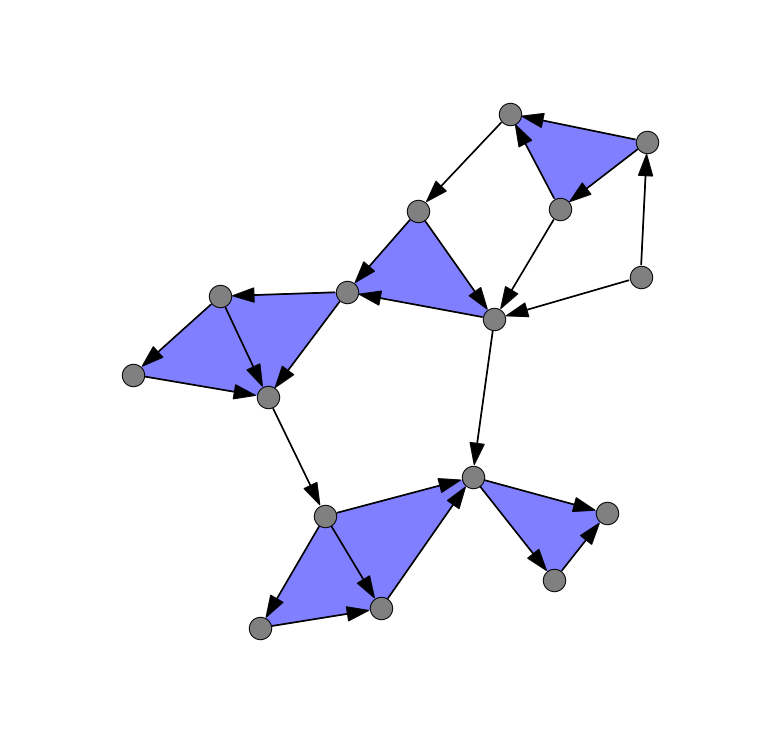
- SUGGESTED TOPICS
- The Magazine
- Newsletters
- Managing Yourself
- Managing Teams
- Work-life Balance
- The Big Idea
- Data & Visuals
- Reading Lists
- Case Selections
- HBR Learning
- Topic Feeds
- Account Settings
- Email Preferences
Research: What Companies Don’t Know About How Workers Use AI
- Jeremie Brecheisen

Three Gallup studies shed light on when and why AI is being used at work — and how employees and customers really feel about it.
Leaders who are exploring how AI might fit into their business operations must not only navigate a vast and ever-changing landscape of tools, but they must also facilitate a significant cultural shift within their organizations. But research shows that leaders do not fully understand their employees’ use of, and readiness for, AI. In addition, a significant number of Americans do not trust business’ use of AI. This article offers three recommendations for leaders to find the right balance of control and trust around AI, including measuring how their employees currently use AI, cultivating trust by empowering managers, and adopting a purpose-led AI strategy that is driven by the company’s purpose instead of a rules-heavy strategy that is driven by fear.
If you’re a leader who wants to shift your workforce toward using AI, you need to do more than manage the implementation of new technologies. You need to initiate a profound cultural shift. At the heart of this cultural shift is trust. Whether the use case for AI is brief and experimental or sweeping and significant, a level of trust must exist between leaders and employees for the initiative to have any hope of success.
- Jeremie Brecheisen is a partner and managing director of The Gallup CHRO Roundtable.
Partner Center
share this!
May 14, 2024
This article has been reviewed according to Science X's editorial process and policies . Editors have highlighted the following attributes while ensuring the content's credibility:
fact-checked
peer-reviewed publication
trusted source
Machine learning model uncovers new drug design opportunities
by Los Alamos National Laboratory
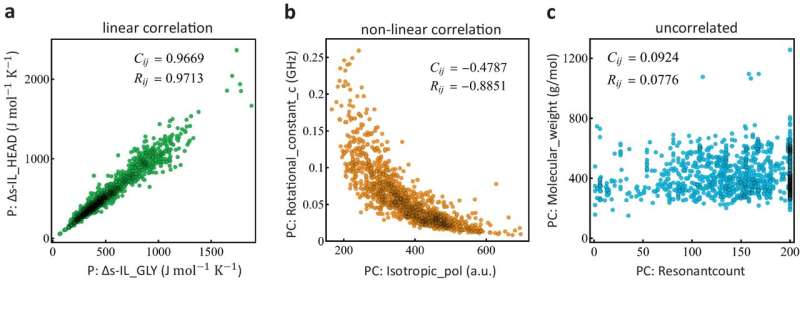
Pathogens are nothing if not adaptable, and their ability to protect themselves against antibiotics increasingly poses a public health concern. A research team led by Los Alamos National Laboratory has used machine learning, an application of artificial intelligence, to identify molecular properties that could guide the discovery of new types of antibiotics, especially among pathogens deemed critical by the World Health Organization due to their high bacterial resistance.
The findings are published in the journal Communications Chemistry .
"Some pathogens have properties that make them very effective at resisting antibiotics," said Gnana Gnanakaran, scientist at Los Alamos. "The discovery of specific compounds able to permeate and inhibit some pathogens is a needle-in-the-haystack challenge due to the vast heterogeneity and depth of the chemical space, and the complexity of the molecular interactions across bacterial membranes. The approach we employ is capable of probing the bacterium-specific, molecular-level profiles necessary that can be built on for successful drug development."
Bacterial defenses against antibiotics
Gram-negative bacteria have an outer membrane less permeable to being breached by compounds, such as those that make up antibiotics, and the bacteria can also expel compounds that happen to get inside, curtailing the effectiveness of an antibiotic.
Data-driven models have potential to identify molecular properties that could overcome such bacterial defenses, but accurate calculations to make those determinations are challenging and use extensive computing resources. Chemically diverse compounds may contain many relevant properties; the machine learning-driven study reduced the relevant spectrum of those properties and established empirical rules that would predict the compound's ability to permeate the bacteria's outer membrane .
Machine learning model identifies pathogen-fighting properties
Focusing specifically on the gram-negative bacteria Pseudomonas aeruginosa, the research team developed a machine learning model to identify the relevant descriptors associated with compounds and predict those compounds' success in permeating bacteria's outer membranes and avoiding expulsion. The team relied on high-performance computing capabilities at Los Alamos to extract the molecular properties of permeation from simulations that considered 1,260 chemically diverse compounds as they traverse the bacterial membrane.
Their analysis sheds new light on the key properties drug candidates need to effectively permeate Pseudomonas aeruginosa, and opens the gate to similar data-driven studies in other gram-negative pathogens.
"The machine learning techniques we've employed in this analysis point to a promising approach for similar data-driven studies in other biological membranes , including the blood-brain barrier ," Gnanakaran said.
Journal information: Communications Chemistry
Provided by Los Alamos National Laboratory
Explore further
Feedback to editors

Blue Origin flies thrill seekers to space, including oldest astronaut
4 hours ago

Composition of gut microbiota could influence decision-making
May 18, 2024

Researchers realize multiphoton electron emission with non-classical light

Saturday Citations: Mediterranean diet racks up more points; persistent quantum coherence; vegan dogs

Physicists propose path to faster, more flexible robots

Scientists develop new geochemical 'fingerprint' to trace contaminants in fertilizer
May 17, 2024

Study reveals how a sugar-sensing protein acts as a 'machine' to switch plant growth—and oil production—on and off

Researchers develop world's smallest quantum light detector on a silicon chip

How heat waves are affecting Arctic phytoplankton

Horse remains show Pagan-Christian trade networks supplied horses from overseas for the last horse sacrifices in Europe
Relevant physicsforums posts, my 'why' questions -- wanting to learn chemistry to figure out my why questions.
2 hours ago
Most dangerous chemicals?
3 hours ago
Potassium Iodide as a catalyst for Hydrogen Peroxide
May 15, 2024
Very confused about Naunyn definition of acid and base
Ideas for a project in computational chemistry, why don't hydrogen ions have osmotic activity in living organisms.
May 6, 2024
More from Chemistry
Related Stories

Team discovers rules for breaking into Pseudomonas
Nov 22, 2023

Study shows that antibiotics targeting the same enzyme elicit varied responses
Mar 15, 2024

When an antibiotic fails: Scientists are using AI to target 'sleeper' bacteria
Apr 8, 2024

Combined treatment using lipid nanoparticles shows promise against antibiotic resistant bacteria
Nov 7, 2023

Examining how the superbug Pseudomonas aeruginosa reacts to antibiotics
Nov 29, 2021

Dozens of potential new antibiotics discovered with free online app
Nov 18, 2019
Recommended for you

Chemists develop new method for introducing fluorinated components into molecules

Chemists develop new method for making gamma chiral centers on simple carboxylic acids

Ion swap dramatically improves performance of CO₂-defeating catalyst
May 16, 2024

Thermoelectric materials approach boosts band convergence to avoid time-consuming trial-and-error approach

Breaking bonds to form bonds: New chemical reaction with potential applications in medicinal chemistry

Accelerated discovery research unveils 21 novel materials for advanced organic solid-state laser technology
Let us know if there is a problem with our content.
Use this form if you have come across a typo, inaccuracy or would like to send an edit request for the content on this page. For general inquiries, please use our contact form . For general feedback, use the public comments section below (please adhere to guidelines ).
Please select the most appropriate category to facilitate processing of your request
Thank you for taking time to provide your feedback to the editors.
Your feedback is important to us. However, we do not guarantee individual replies due to the high volume of messages.
E-mail the story
Your email address is used only to let the recipient know who sent the email. Neither your address nor the recipient's address will be used for any other purpose. The information you enter will appear in your e-mail message and is not retained by Phys.org in any form.
Newsletter sign up
Get weekly and/or daily updates delivered to your inbox. You can unsubscribe at any time and we'll never share your details to third parties.
More information Privacy policy
Donate and enjoy an ad-free experience
We keep our content available to everyone. Consider supporting Science X's mission by getting a premium account.
E-mail newsletter
- Alzheimer's disease & dementia
- Arthritis & Rheumatism
- Attention deficit disorders
- Autism spectrum disorders
- Biomedical technology
- Diseases, Conditions, Syndromes
- Endocrinology & Metabolism
- Gastroenterology
- Gerontology & Geriatrics
- Health informatics
- Inflammatory disorders
- Medical economics
- Medical research
- Medications
- Neuroscience
- Obstetrics & gynaecology
- Oncology & Cancer
- Ophthalmology
- Overweight & Obesity
- Parkinson's & Movement disorders
- Psychology & Psychiatry
- Radiology & Imaging
- Sleep disorders
- Sports medicine & Kinesiology
- Vaccination
- Breast cancer
- Cardiovascular disease
- Chronic obstructive pulmonary disease
- Colon cancer
- Coronary artery disease
- Heart attack
- Heart disease
- High blood pressure
- Kidney disease
- Lung cancer
- Multiple sclerosis
- Myocardial infarction
- Ovarian cancer
- Post traumatic stress disorder
- Rheumatoid arthritis
- Schizophrenia
- Skin cancer
- Type 2 diabetes
- Full List »
share this!
May 15, 2024
This article has been reviewed according to Science X's editorial process and policies . Editors have highlighted the following attributes while ensuring the content's credibility:
fact-checked
trusted source
AI-based surgical prediction models have limits
by Flinders University

Prediction models generated by machine learning are being increasingly used in medicine to identify risk factors and possible outcomes, especially for total joint replacements of knees and hips—although researchers warn that machine-generated predictions are currently being drawn from a limited data pool.
"Machine learning has great potential for processing 'big data' and has proved its undeniable capability, although it is not free of issues," warns Dr. Reza Hashemi from Flinders University's College of Science and Engineering.
"The accuracy of predictive models is dependent on the quality of the data sources, and predictions may be significantly affected by the amount of data and the number of variables included."
"At present, predictive models developed for total hip reconstruction and total knee reconstruction are based mainly on patient-reported factors and imaging variables. Therefore, the output of machine learning models in this area needs to be interpreted carefully."
To study the application of supervised machine learning in predictive modeling for post-operative outcomes of total hip and knee replacements, Flinders researchers together with collaborators from the Australian Orthopedic Association National Joint Replacement Registry (AOANJRR), Royal Adelaide Hospital and UniSA assessed the most-widely used machine learning techniques, data sources, domains, limitations of predictive analytics and the quality of predictions.
The research , "Supervised machine learning for the prediction of post-operative clinical outcomes of hip and knee replacements: a review," has been published in ANZ Journal of Surgery .
"The most widely used machine learning approach in medical sciences is 'supervised learning,' which estimates the mapping function for new input data in order to predict categorized, real values, or time-to-event outputs," says research co-author, Flinders University's Dr. Khashayar Ghadirinejad.
Conventional statistical methods of risk predictions rely on predetermined assumptions and mathematical equations to formalize relations between the variables, whereas machine learning techniques use large amounts of available data to recognize these relationships.
In assessing the effectiveness of machine learning to assist with total hip replacement and total knee replacement procedures, the researchers note that care should be taken by the medical profession when dealing with limited data on specific subjects.
Dr. Ghadirinejad suggests machine learning models should now be assessed and evaluated using a randomized cohort of studies and controlled trials in real-world settings, rather than just assessing data. "More improvements are needed in machine learning orthopedic applications to translate research aims into clinical practices," he says.
Despite the current limitations of machine learning, the researchers recognize there is still a need for models that can predict various outcomes such as the early identification of prostheses outliers based on the available big data from the national joint registries around the world.
Joint registries aim to reduce the revision rates of arthroplasty surgeries by early detection of outlier joint arthroplasty devices. They provide population-based data on the comparative outcome of prostheses within the community. Joint registries, in particular the Australian Joint Registry, put efforts to significantly control the harm and cost of using poor-performing devices in hip and knee replacement surgeries.
The authors also suggest a future direction for machine learning in the domain of joint arthroplasty could be to develop decision-making support systems focused on pre-surgical predictions that enable surgeons to determine what is the best for their patients individually.
Explore further
Feedback to editors

New analysis estimates the effects of race-neutral lung function testing on patients, hospitals, and beyond
4 hours ago

World-first trial shows benefits of finding and treating undiagnosed asthma and COPD
8 hours ago

Acetaminophen shows promise in warding off acute respiratory distress syndrome, organ injury in patients with sepsis
11 hours ago

Modular communicative leadless ICD found to be safe and exceeds performance expectations
May 18, 2024

Creativity and humor shown to promote well-being in older adults via similar mechanisms

Sweet taste receptor affects how glucose is handled metabolically by humans

Better medical record-keeping needed to fight antibiotic overuse, studies suggest

Repeat COVID-19 vaccinations elicit antibodies that neutralize variants, other viruses

A long-term ketogenic diet accumulates aged cells in normal tissues, new study shows
May 17, 2024

Gut bacteria enhance cancer immunotherapy in mouse study
Related stories.

A theoretical model for reliability assessment of machine learning systems
Feb 1, 2024

Artificial intelligence may help predict infection risks after implant-based breast reconstruction
Oct 24, 2023

Down syndrome and joint replacement: Risks for post-surgical complications
Jan 11, 2024

Review examines machine learning concepts for microbiologists
Dec 6, 2023

Machine learning models can produce reliable results even with limited training data
Sep 19, 2023

Scientists could discover physical laws faster using new machine learning technique
Dec 15, 2021
Recommended for you

Artificial intelligence and the future of surgery

Research team develops new AI tool to help classify brain tumors

Researchers reveal molecular mechanisms of different donor arteries for coronary artery bypass grafting

Global life expectancy projected to increase by nearly 5 years by 2050 despite various threats
May 16, 2024

Study finds reduced risk of breast cancer following bariatric surgery in women with hyperinsulinemia
Let us know if there is a problem with our content.
Use this form if you have come across a typo, inaccuracy or would like to send an edit request for the content on this page. For general inquiries, please use our contact form . For general feedback, use the public comments section below (please adhere to guidelines ).
Please select the most appropriate category to facilitate processing of your request
Thank you for taking time to provide your feedback to the editors.
Your feedback is important to us. However, we do not guarantee individual replies due to the high volume of messages.
E-mail the story
Your email address is used only to let the recipient know who sent the email. Neither your address nor the recipient's address will be used for any other purpose. The information you enter will appear in your e-mail message and is not retained by Medical Xpress in any form.
Newsletter sign up
Get weekly and/or daily updates delivered to your inbox. You can unsubscribe at any time and we'll never share your details to third parties.
More information Privacy policy
Donate and enjoy an ad-free experience
We keep our content available to everyone. Consider supporting Science X's mission by getting a premium account.
E-mail newsletter
- Frontiers in Molecular Biosciences
- Molecular Diagnostics and Therapeutics
- Research Topics
Recent Advances in Breath Analysis: Exploring Exhaled Breath Biomarkers for Disease Diagnostics
Total Downloads
Total Views and Downloads
About this Research Topic
Breathomics is a branch of metabolomics that analyzes various volatile organic compounds (VOCs) from exhaled breath samples. It has been rapidly growing as a non-invasive diagnostic tool to probe or infer the pathogenic or physiological status of the human body, often yielding crucial information for disease diagnostics. Unlike traditional diagnostic methods that often require invasive procedures or complex laboratory analyses, breath analysis offers a simple, cost-effective, and patient-friendly approach that can be easily integrated into routine clinical practice. The non-invasive nature of breath sample collection makes breathomics particularly attractive for disease screening, monitoring, and personalized medicine. Understanding the link between breath molecules and diseases has gained significant advances due to recent developments in more reliable detection techniques and standardized breath sample collection methods. Additionally, the recent rapid progress in algorithm development, including machine learning and artificial intelligence, has unveiled intriguing associations between breath VOCs and diseases that were previously convoluted by multiple factors. With successful clinical applications of gastrointestinal and respiratory diagnostics, breath analysis has expanded to broader fields such as thoracic diseases, neurological disorders, pharmacokinetics, and more. The surge in registered clinical trials employing breath analysis and breathomics underscores the growing significance and potential of this innovative approach in modern healthcare. The objective of this Research Topic is to provide a comprehensive overview of the recent advancements in breathomics, with a particular focus on exploring the association between exhaled breath VOCs and diseases. The aim is to delve deeper into the scientific underpinnings of this emerging field and to assess its potential in modern healthcare. Focusing on the following four areas: • Investigating the mechanism of breath biomarkers and diseases, including assessing unique VOC signatures associated with different diseases, potential VOC profiles for early disease screening, and influences of various factors such as diet, lifestyle, and environmental exposure on breath VOC composition. • Advancements in breath analysis technologies, including novel analytical techniques for the detection and quantification of VOCs in exhaled breath and applications of standardized protocols for breath sample collection, storage, and analysis. • Machine learning and AI-driven data processing in breathomics, including the development of predictive models for disease classification and risk prediction, integration of multi-omics data with breathomics data for comprehensive disease profiling, and validation strategies for assessing the robustness and generalizability of AI-driven models. • Clinical applications of breathomics, including evaluation of breathomics-based diagnostic tools in clinical settings, monitoring disease progression and treatment response through longitudinal breath analysis or pharmacokinetics studies, and exploring the potential of breathomics in personalized medicine and disease screening. Topic editor Meixiu Sun is employed by WIM Spirare Health Technology Limited. The other Topic Editors declare no potential conflicts of interest with regards to the Research.
Keywords : breath analysis, breathomics, volatile organic compounds (VOC), disease diagnostics, machine learning, artificial intelligence
Important Note : All contributions to this Research Topic must be within the scope of the section and journal to which they are submitted, as defined in their mission statements. Frontiers reserves the right to guide an out-of-scope manuscript to a more suitable section or journal at any stage of peer review.
Topic Editors
Topic coordinators, submission deadlines, participating journals.
Manuscripts can be submitted to this Research Topic via the following journals:
total views
- Demographics
No records found
total views article views downloads topic views
Top countries
Top referring sites, about frontiers research topics.
With their unique mixes of varied contributions from Original Research to Review Articles, Research Topics unify the most influential researchers, the latest key findings and historical advances in a hot research area! Find out more on how to host your own Frontiers Research Topic or contribute to one as an author.

IMAGES
VIDEO
COMMENTS
Machine learning research is at the heart of the AI revolution. It underpins the development of intelligent systems capable of making predictions, automating tasks, and improving decision-making across industries. The importance of this research can be summarized as follows: Advancements in Technology.
Machine learning articles from across Nature Portfolio. Machine learning is the ability of a machine to improve its performance based on previous results. Machine learning methods enable computers ...
Get 1-On-1 Help. If you're still unsure about how to find a quality research topic, check out our Research Topic Kickstarter service, which is the perfect starting point for developing a unique, well-justified research topic. A comprehensive list of research topics ideas in the AI and machine learning area. Includes access to a free webinar ...
3.) Auto Machine Learning. Auto machine learning is a research topic in data science concerned with developing algorithms that can automatically learn from data without intervention. This area of research is vital because it allows data scientists to automate the process of writing code for every dataset.
OS-Copilot/FRIDAY • 12 Feb 2024. Autonomous interaction with the computer has been a longstanding challenge with great potential, and the recent proliferation of large language models (LLMs) has markedly accelerated progress in building digital agents. Papers With Code highlights trending Machine Learning research and the code to implement it.
To discuss the applicability of machine learning-based solutions in various real-world application domains. To highlight and summarize the potential research directions within the scope of our study for intelligent data analysis and services. The rest of the paper is organized as follows.
The general problem is referred to as unsupervised learning, a second paradigm in machine-learning research . ... or a collection of submanifolds). Another example of dimension reduction is the topic modeling framework depicted in Fig. 3. A criterion function is defined that embodies these assumptions—often making use of general statistical ...
Machine Intelligence. Google is at the forefront of innovation in Machine Intelligence, with active research exploring virtually all aspects of machine learning, including deep learning and more classical algorithms. Exploring theory as well as application, much of our work on language, speech, translation, visual processing, ranking and ...
A variety of innovative topics are included in the agenda of the published papers in this special issue including topics such as: Stock market Prediction using Machine learning ... Z., Brahimi, T. et al. Artificial intelligence and machine learning research: towards digital transformation at a global scale. J Ambient Intell Human Comput 13 ...
Explore the latest full-text research PDFs, articles, conference papers, preprints and more on MACHINE LEARNING. Find methods information, sources, references or conduct a literature review on ...
Each thesis idea includes an introduction, which presents a brief overview of the topic and the research objectives. The ideas provided are related to different areas of machine learning and deep learning, such as computer vision, natural language processing, robotics, finance, drug discovery, and more.
Real-time machine learning models are a trending machine learning topic for 2021. More advanced machine learning operation (MLOps) and real-time data is a powerful combination, one that gives us real-time machine learning. Traditionally, machine learning models are trained on batches of historical data. Training ML models by feeding them real ...
Topic Machine learning. Download RSS feed: News Articles / In the Media / Audio. Displaying 1 - 15 of 896 news articles related to this topic. ... and MIT are working toward novel solutions to the world's problems as part of the Designing for Sustainability research program.
Artificial intelligence can provide accurate forecasts of extreme floods at global scale. Anthropogenic climate change is accelerating the hydrological cycle, causing an increase in the risk of ...
Overview. Machine Learning is an international forum focusing on computational approaches to learning. Reports substantive results on a wide range of learning methods applied to various learning problems. Provides robust support through empirical studies, theoretical analysis, or comparison to psychological phenomena.
It reveals new and up-to-date insights into what the 10 most prolific topics in machine learning research are. This allows researchers to identify popular topics as well as new and rising topics for their research. Subjects: Machine Learning (cs.LG); Artificial Intelligence (cs.AI); Machine Learning (stat.ML) Cite as: arXiv:1703.10121 [cs.LG]
We study a range of research areas related to machine learning and their applications for robotics, health care, language processing, information retrieval and more. Among these subjects include precision medicine, motion planning, computer vision, Bayesian inference, graphical models, statistical inference and estimation. Our work is ...
Find the latest published documents for machine learning, Related hot topics, top authors, the most cited documents, and related journals. ScienceGate; Advanced Search; Author Search ... This article examines the background to the problem and outlines a project that TNA undertook to research the feasibility of using commercially available ...
Register Now for ODSC West 2021. At our upcoming event this November 16th-18th in San Francisco, ODSC West 2021 will feature a plethora of talks, workshops, and training sessions on machine learning topics, deep learning, NLP, MLOps, and so on. You can register now for 20% off all ticket types, or register for a free AI Expo Pass to see what ...
In this Research Topic, we are seeking to bring together researchers from machine learning and computational neuroscience and to stimulate collaboration between researchers in these fields. More specifically, this collection of articles is intended to cover recent directions and activities in the field of machine learning, especially the recent ...
8. The Hottest Topics in Machine Learning. In the Hottest Topics in Machine Learning project, you will use text processing and LDA(Linear Discriminant Analysis) to discover the latest trend in machine learning from the large collection of NIPS research papers. You will perform text analysis, process the data for word cloud, prepare data for LDA ...
Add this topic to your repo. To associate your repository with the machine-learning-research topic, visit your repo's landing page and select "manage topics." GitHub is where people build software. More than 100 million people use GitHub to discover, fork, and contribute to over 420 million projects.
Towards precision medicine for cancer patient stratification. Unraveling gene regulation from single cell data. Developing a Stress Granule Classifier. Machine Learning based Hyperheuristic algorithm. Machine learning for solving satisfiability problems and applications in cryptanalysis. Hybrid modeling approaches for well drilling with Sintef.
Ohio State University. "New machine learning algorithm promises advances in computing." ScienceDaily. ScienceDaily, 9 May 2024. <www.sciencedaily.com / releases / 2024 / 05 / 240509155536.htm ...
2. Data Science: Machine Learning - Harvard. Data Science: Machine Learning is another course where you'll get to learn machine learning fundamentals by working on practical applications such as movie recommendation systems. The course goes over the following topics: Link: Data Science: Machine Learning. 3.
Read more on AI and machine learning or related topics Leadership, Organizational culture, Corporate strategy, Leadership vision, Digital transformation and Technology and analytics Partner Center
Machine learning model identifies pathogen-fighting properties. Focusing specifically on the gram-negative bacteria Pseudomonas aeruginosa, the research team developed a machine learning model to ...
DALLAS - May 13, 2024 - A team led by researchers at UT Southwestern Medical Center developed deep learning models to identify a simple set of rules that govern the activity of promoters - regions of DNA that initiate the process by which genes produce proteins. Their findings, published in Science, could lead to a better understanding of ...
The research, "Supervised machine learning for the prediction of post-operative clinical outcomes of hip and knee replacements: a review," has been published in ANZ Journal of Surgery.
Keywords: breath analysis, breathomics, volatile organic compounds (VOC), disease diagnostics, machine learning, artificial intelligence . Important Note: All contributions to this Research Topic must be within the scope of the section and journal to which they are submitted, as defined in their mission statements.